Edgell/Deves/Pagenkopf Family Genealogy
The Edgell genealogy of this Edgell line stems from Benjamin Edgell, Dorchester County Maryland in the mid-1700s.
The Deves side of the family, the mother’s side, has been traced back to the late 18th Century to the Pagenkopf family of Pomerania.
Ancestry DNA Results
Ancestry.com offers a service to members and non-members to analyze their DNA results. Robert Edgell of Generation IX sent in a sample and the following are the
results.
The ethnicity and region results reveal that Robert Edgell's DNA is:
- 49% Europe and northern Europe. This will likely be the German and Pomeranian strain from the mother's side (Deves).
- 24% Scottish. This is from the father's side, Edgell.
- 6% England and Ireland
- The remaining is a mixture of British Isles and Europe.
Included in the report is a list of cousins and If a cousin has submitted a DNA it will list that cousin. In the edgell report there were over 1,000 4-6th cousins registered. It also contained the name of a step-second-cousin of the Generation X.
EDGELL:
The main ancestors of this line are:
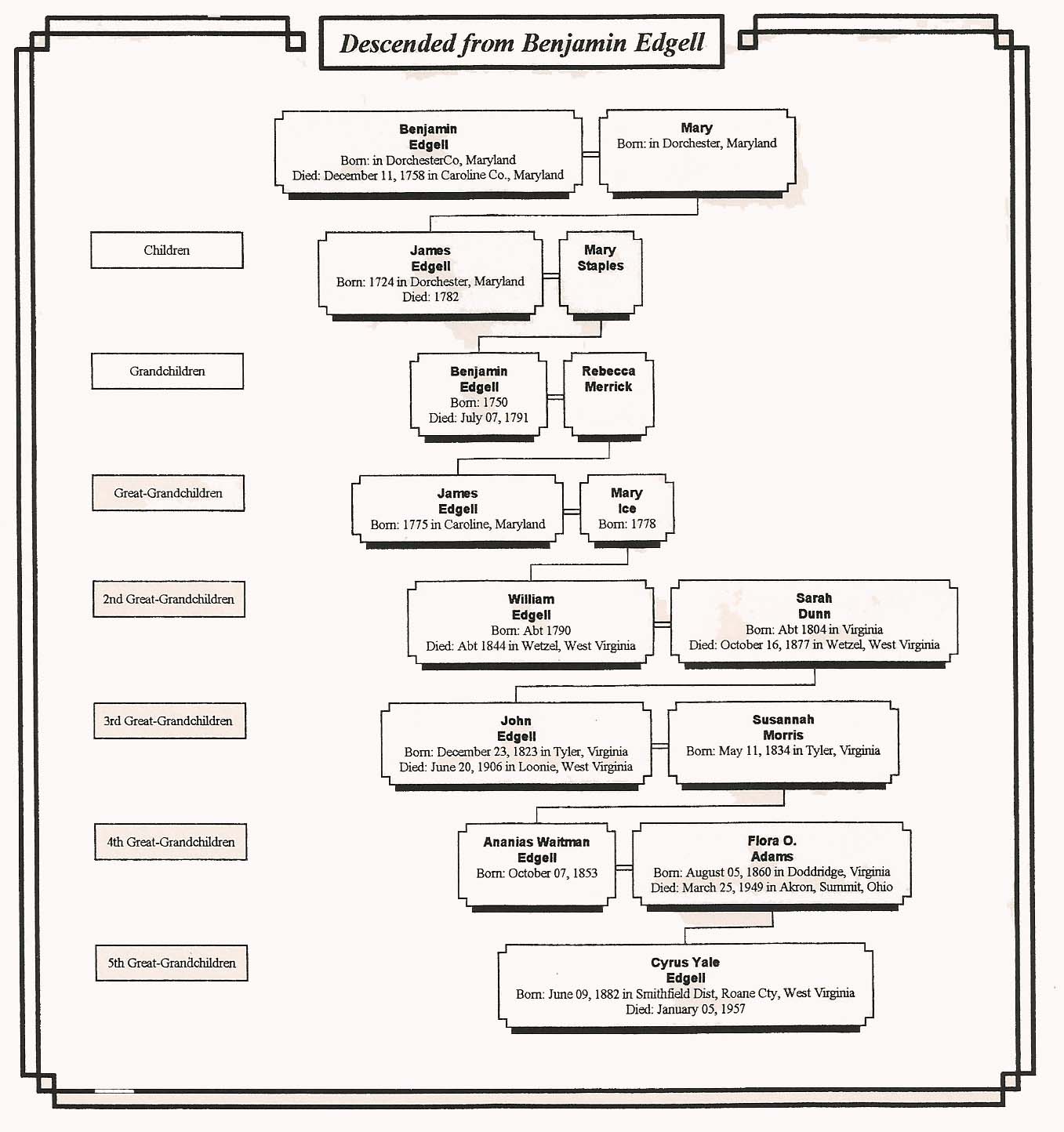
GEN I Benjamin Edgell - Dorchester County, Maryland
Purchased a parcel of land (220 Acres) near Preston, Maryland called Fluharty’s Desire for 3,000 pounds of tobacco: recorded in Dorchester County November 14, 1716. In January 1757 he made a will, leaving one Shilling each to his children: James, Thomas, Catherine, Mary, and Walter (and Walter’s son, William). To his son John, he left the house, land, plantation, all personable estates and the parcel (50 acres) called Steven Fluharty’s Desire. Benjamin Sr. died in 1758., leaving 500 pounds sterling. John Edgell was the executor of the estate. James and Thomas approved of the inventory.
GEN II James Edgell (b. 1724, Dorchester, County) and Mary Staples.
Married to Mary Edgell and their names are on the deed for a portion of Fluharty’s Desire. James was a carpenter in Dorchester County. James deeded part of his land, “Brotherhood”, to his brother John in 1748. December 13, 1769, James deeded to his son Benjamin, 116 acres of an addition to Fluharty’s Desire. Recorded in Dorchester Deed records. James made his will on April 20, 1782 as recorded in Caroline County Wills. He left to his son Abraham his dwelling and made bequests to Abraham’s sons, James and Robert Edgell.
GEN III Benjamin Edgell (b. 1750) and Rebecca Merrick
Married to Rebeccah. Caroline County made his will on January 6, 1791. He left all his real and personal property to his widow, Rebeccah which consisted of two tracts of Fluharty’s Desire and an Addition to Fluharty’s Desire were to go to his son, Ezekiel Edgell. Ezekiel shall keep his son Jesse to live with him. Allin shall get the land if Ezekiel dies without lawful issue.
GEN IV Ezekiel Edgell (4) Son of Benjamin (3)
Made his will, December 1812 (Caroline County Wills). EN Page 5.
GEN IV Jesse Edgell (4) Son of Benjamin (3) Born June 10, 1774, in Caroline County, Maryland. Married Mary Jester, daughter of Reverend Daniel and Elizabeth Jester, September 17, 1799. Will of Mary.

GEN IV James Edgell and the story of Mary Ice and Tecumseh James Edgell and Mary Ice (b. 1778)
GEN IV William Edgell (b. 1790) in Virginia. Married Sarah Dunn (b. 1804) in Virginia
GEN V John Edgell (b. 12/23/1823, Tyler, Virginia. Married Susannah Morris (b. 5/11/1834).
GEN VI Ananias W. Edgell (b. 10/7/1853). Married Flora O. Adams (8/5/1860, Dodderidge, Va).
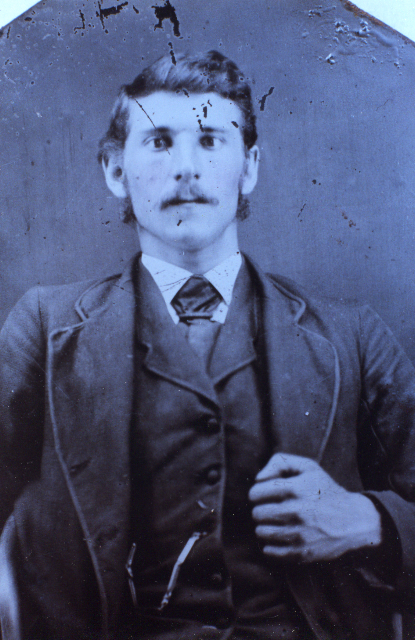
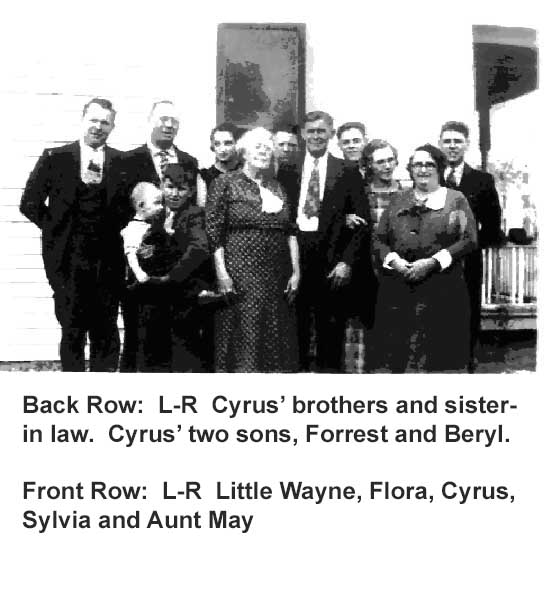
A.W. and Flora lived in Rhone, W. Virginia. They had six boys and four girls.
Two of their sons are remembered here: Cyrus Yale and Ora Klyde. Rumor: related
to Sir Walter Raleigh. See Notes under Waitman
The first born of A.W. and Flora, Ora attended Medical College in St. Louis
Missouri, graduated in 1902. Married Hester Lorney, 10/27//1900. Two sons,
Holden Hearst (b 8/21/1902) Preston Dwight (b 3/7/1904)
Ora remarried on 2/2/1924 to Sue Adams. One son, James Klyde (b 1/13/1926) Ora
died 5/8/1945 at his son’s home in Washington.
GEN VII Cyrus Y. Edgell (b. 6/9/1882) Looneyville, W. Va) Married:
Sylvia J. South (5/24/1887), Howard, Oh).

Sylvia Jane South Family line:
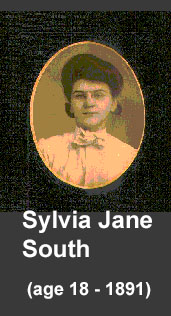
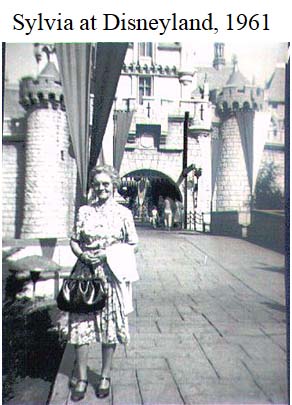
GEN I of Sarah Jane South - Lendwig Bricken Holland, Germany b. 1754. Married Elizabeth Calvert, b.
Maryland, USA.
(Great, Great, Great Grandparents of Sylvia Jane South Edgell. The Calverts are
reputed to have had ownership of the Baltimore Railroad). Elizabeth Calvert
(unconfirmed) might have been a daughter of the Calvert family, 6th Baron Lord
Baltimore, the family that ruled and owned most of Maryland for generations,
until the American Revolution.
GEN II: Jacob Bricken. Married Mary Koonsman Great, Great Grandparents
of Sylvia Jane South Edgell. They bore a child, Elizabeth Bricken.
GEN III: Elizabeth Bricken, Lived to be 104 years old. Married William Hogue
born 1810
Great Grandparents of Sylvia Jane South Edgell.
GEN IV: Daughter - Mary Hogue born 1832, Ohio, USA. Married Samual South
Sr, b 1871 Baltimore, MD.
GEN V: Samual South, Junior, born August 26, 1861. Knox, Ohio. Died
March 22, 1890
Married: Sarah Jane Tweed. born 1863, Howard (Knox Cty)
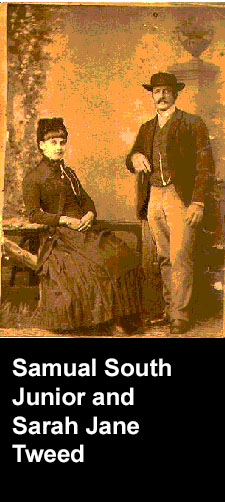
GEN VI: Daughter - Sarah Jane South. Born June 24, 1887
Married Cyrus Yale Edgell
Sylvia’s dad, Samual South Jr. Died in 1887 when Sylvia was three years old.
Sarah remarried George Young (d. Nov. 23, 1969) and they had four children:
Blanche: b 2/7/1894 (married Joseph Boyer:three children; Marion, Lillian,
Gerald)
Evelyn: b 9/2/1896 (suicide age 42)
Lorraine: b 1/12/1901 d 8/30/1969
EDGELL LINE CONTINUED:
GEN VII Cyrus Y. Edgell (b. 6/9/1882) Looneyville, W. Va) Married: Sylvia J. South (5/24/1887), Howard, Oh.



Cyrus left W. Virginia and traveled to Akron, Ohio on July 4, 1903. He was
employed in the rubber works in Akron. Cyrus was told by a doctor he had six
months to live and moved the family to Colorado in 1923. He was in the
grocery business until retirement in 1953. Cyrus and Sylvia bore 3 sons and
one daughter. Died 1/5/1957 of coronary artery occlusion.
GEN VIII Harold South Edgell (oldest son of Cyrus and Sylvia) b
11/27/1913, Cuyahoga Falls, Oh. Married: 8/3/1936 Alese Priest who
passed away in 1970s. Harold then cohabited with Ruth Burns, b. 12/26/1910
Kansas City, Kansas.

Harold's words from his chornicles: "When I was 11 years old, dad was told
by doctors he had 6 months to live because of a lung infection. The doctors
told him he had to move to a high elevation climate. On the way to Colorado,
dad stopped in Hannibal Missouri and talked to Uncle Ore who was a doctor.
Ore agreed with the doctors and told dad to go live in a high climate. I
remember Uncle Ore and to this day have no respect or kinship for him. Dad
worked and paid for Ore’s education with the understanding that when Ore
became a doctor, he would put the others through college and help with their
education. Ore never gave back anything to the family. After he graduated,
Ore moved to Missouri and never contributed to the family or to dad’s
education. Dad moved his family to Colorado and lived for another 40 years.
When the family moved to Colorado, I stayed with Grandma Edgell, Flora, in
Akron, Ohio for a year. This was a burden on Grandma and I knew, at that
young age, that she did not want me. This caused me to be belligerent. Dad,
mom and my two brothers were gone and I was left alone in a home where I was
not wanted. Grandma was a wonderful person but very strict in her ways. My
belligerence resulted in a very difficult time at school and I would get
into fights on the school yard almost every day. I would come home every day
with a bloody face and clothes. Grandma made me black clothes so that the
stains would not show and I would not look dirty and bloody.
Alese was a very good tennis player and won several tournaments involving
charities and clubs. She inspired me to keep up my tennis game to a
respectable level.
After over eight decades of living, I consider myself fortunate. My health
is good, my finances are sound and I am lucky to have a wonderful, loving
companion in Ruth. To all the later generations of Edgells, I wish you the
best and may God give you the energy, common sense and good fortune to live
so long and have someone like Ruth at your side."
Harold had a long career in purchasing at Gates Rubber Company, Denver,
Colorado. Here he is on the cover of their company magazine. Harold and
Elese were avid tennis players and traveled extensively.
GEN VIII Helen Faye Edgell (daughter to Cyrus and Sylvia (b. 9/25/1915 Akron, Ohio) (d. 2020 age 105). Married 1935 in Loveland Colorado: William Frederick Riker (b. 4/18/1913).
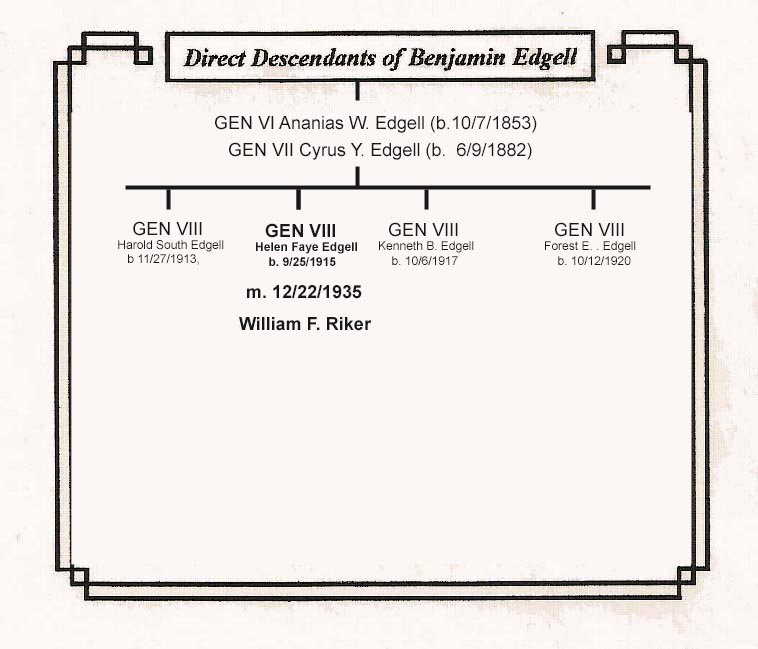
Helen Moved to Loveland, Colorado in 1923. Graduated from Loveland High in
1933. Attended Beautician school in Denver to run her shop in Berthoud.
Married William Riker December 22, 1935
Helen's words from her Chronicles: "I was born in Akron, Ohio September
25,1915 to Sylvia Jane and Cyrus Yale Edgell who were happy to have a sweet
little girl who never cried in the night, keeping them up all hours. My
older brother, Harold, on the other hand,, had a respiratory problem and Dad
and Mom walked the floor with him night after night. I adored him and loved
him with all my might. He goes by Bud and is a man I am proud of. Kenneth
Beryl was born October 6, 1917 and Forest Earl October 12, 1920. Two
wonderful brothers who grew up close sharing everything just as if they were
twins. Beryl was very close to Mother, a big help and thoughtful of her. He
helped around the house, cleaning the toilets and floors and doing the
grocery shopping for Mother. Forest was a little chubby lovable baby we
affectionately called “Fat”. That name stuck until he started school. Then
he was Forest. When he met Lola Rankin, she nicknamed him Fory. To me it is
an endearing name for my brother and that is what I like to call him.
Dad was a good man, firm in teaching us right from wrong. He lived by the 10
commandments as given by God to Moses on Mt. Sinai.
We had a happy home with love for all. I remember when Grandma Edgell Ellis
and Mr. Ellis, her husband came to live with us, I must have been 6 years
old. I was overjoyed to have her near, because she gave the best, loving
hugs in the whole wide world and took the time to play dolls and make
believe with me.
My mother, Flora O. Adams Edgell Ellis was a special person. One thing I
didn’t understand was she would reach in her pocket and take out a can and
use snuff, but I didn’t care because she would rock and smile her sweet
loving smile and all seemed right with the world. In those days, Grandma
wore long print dresses and a white apron with big pockets.
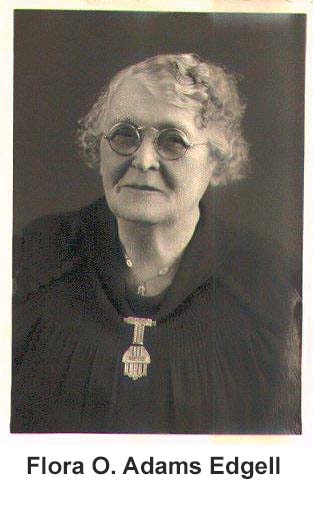
The ranch where we lived two miles from Divide was called Tucked a’Way. Later that Fall we moved to Ramah, Colorado where my parents managed a Hotel. They rented out rooms, cooked, cleaned, did laundry, and anything else that needed done. I was the only waitress and I got lots of tips the three years. I was 8,9, and 10 years old and able to buy all my school books and clothes. Four or five teachers lived with us and were called our “regulars”.

We later moved to Loveland, Colorado. In Loveland, Mother did home nursing
to help with expenses. She was so sweet to older people and took care of all
their needs. Everyone loved her. On Saturdays, she baked bread and Parker
House Rolls and Forest and Beryl went door to door selling her baked goods
hot from the oven. We always got orders for the next bake day. Beryl and
Forest won the hearts of all the families for blocks around us. I can see
them yet with their baskets of hot bread and rolls. A loaf of bread was 15
cents and rolls 25 cents a dozen. My brother, Harold, had a job and gave his
checks to the folks to help out.
My freshman year in high school, I met this handsome young man, William
Frederick Riker, a senior who stole my heart away and we started going
steady. He graduated from High School that year and in the Fall went off to
Boulder to attend the University. On December 22, 1935, Bill and I were
happily married. January 31, 1939 a “blessed event” a baby girl was born. We
named her with some insistence from her Granddad Riker, Nellie Jane, after
her two grandmother, “Nellie” Riker and Sylvia “Jane” Edgell. When our
daughter was born, my mother came to see the baby and help me for a couple
of weeks. Mom and Dad had moved to Goodland, Kansas in 1935.
My brother, Kenneth Beryl Edgell. Beryl was one of the first to be
selectively inducted into the army. After Boot Camp he was sent to Officers
Training School where she was able to join him. After he graduated she went
home to live with her folks and have their baby girl, Lois Sylvia - named
after 2 grandmothers. I was so thankful Beryl took the time to come to
Denver to say goodbye to Mother and Dad, Bud and Alese and to Loveland to
say goodbye to me and my family. It was the last time we saw him.
After the invasion of Normandy Beach, my brother Beryl was reported missing in action for 2 years. It was so hard on Mother, Dad, his wife Esther and all of us. One theory in my mind was that he had amnesia from the horror of the Normandy Beach invasion. Where ever I went I looked for him, on the streets, in stores, in crowds, and I kept that up until (after 2 years) the word came that he had died in battle and they sent some of his things home. I can’t even guess what agony my parents went through to lose a child, no matter what age, is one of the worst crosses to bear. My heart ached for Mother and Dad.
When my brother, Forest, was in Army boot camp, his wife Lucille left him for a man named Tex and brought all three of his boys to Cheyenne to the base where he was stationed. Forest took them to Mom and Dad’s but they were managing an apartment where children were not allowed. Their hearts were broken when they had to put the two little boys in foster care. Lucille picked up the two little boys after some time, but left Lynn. I took Lynn in and he stayed with us through three school years, I believe 3rd, 4th, and 5th grade."
Helen's Obituary.
September 25, 1915 - November 24, 2018 Helen passed away peacefully at her
home in Sherwood, Ore. on November 24, 2018 after turning 103 on her
birthday September 25, 2018. Helen passed away peacefully at her home in
Sherwood, Ore. on November 24, 2018 after turning 103 on her birthday
September 25, 2018. My sister, Sharyn and her children, came from California
to celebrate. Helen lived with her daughter, Lee Johnson and her husband,
Chuck. Their daughter and son-in-law live close where they were able to help
with Helen's care. Helen's 3 husbands preceded her in death. Helen was born
in Akron, Ohio to Cyrus and Sylvia Edgell, but because of health issues
moved to the mountains in Denver, CO. where they raised Helen and her 3
brothers. She moved to southern California after her first husband, Bill
Riker died. She soon fell in love with Ellis Midgett who had two children,
Sharyn and Ken. After Ellis retired, they bought property in Hemet, Calif.
where they were able to swim every day, walk, dance and lawn bowl. It was a
very sad day when Ellis died of cancer. Her last husband, Leonard Smith, saw
her lawn bowling and instantly fell in love but once again she lost him to
cancer. They enjoyed traveling and camping and visiting with the children in
Calif. and Oregon. When Helen turned 80, she decided to move to Sherwood,
Ore. to be close to Lee, Chuck and their children and go to the beach and
live theater. She has always been active in the Methodist church and loved
the ladies group that met monthly for lunch. Helen is survived by her
daughter, Lee Johnson and husband, Chuck; daughter, Sharyn Stoddard; and
daughter-in-law, Linda Midgett; 11 grandchildren; and 18 great-
grandchildren. There will be a celebration of life this summer at Cannon
Beach, Oregon.
Daughter:
GEN IX Nellie Jane Riker (Helen's daughter) (b. 1/31/1939 Spokanne,
Washington d. 2022 Sherwood, Oregon)
Married:Charles Robert Johnson b. 12/23/30 Newbury, Michigan.
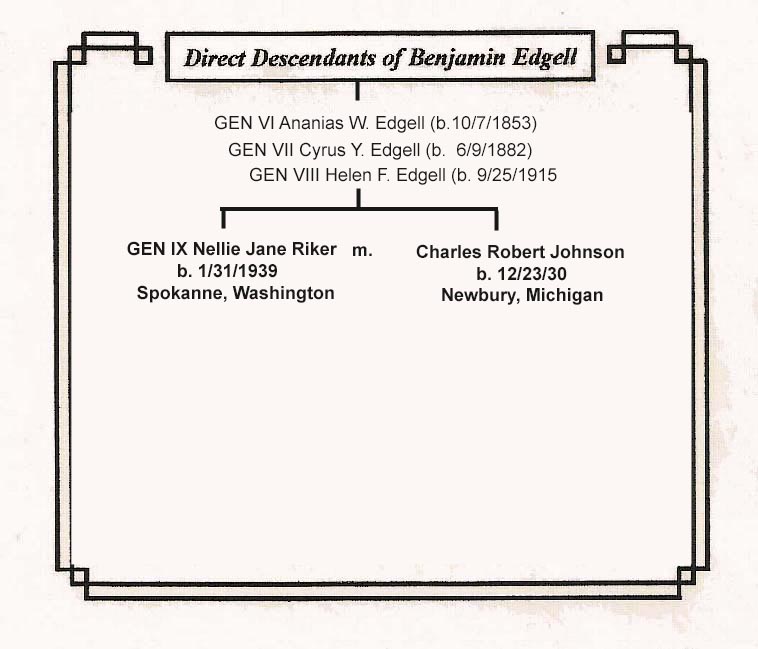
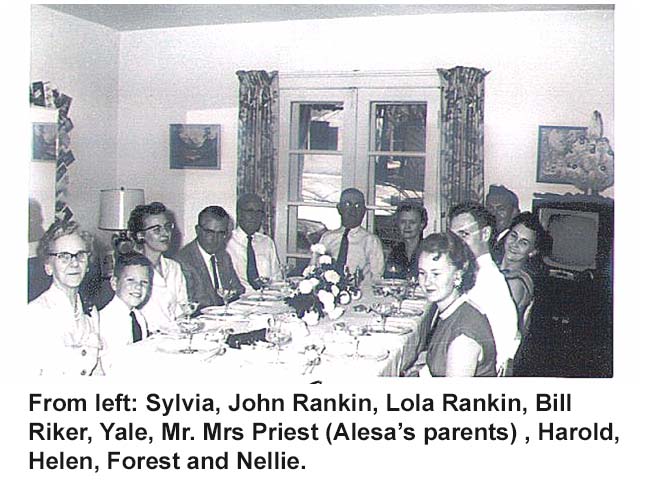

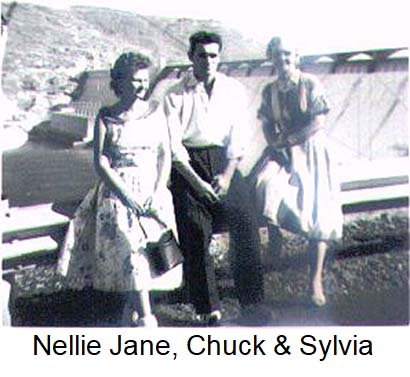
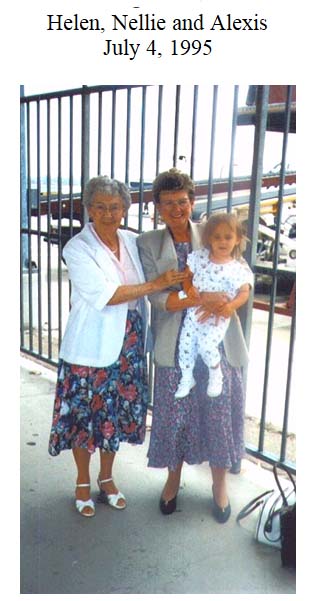
Nellie's two Daughters and a son.
GEN X Celeste Renee Johnson (Nellie's daughter) b. 3/11/1961 Lewiston, Idaho Married: Stuart M. Hartman b. 3/12/1961
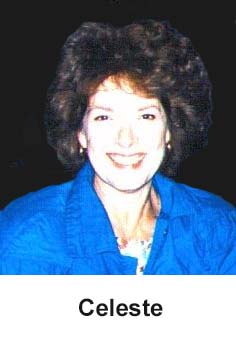

Celeste words from her Chronicles: "I was born on March 11, l961 in Lewiston, Idaho at St. Joseph’s Hospital. Lewiston is located in northwestern Idaho just South of Moscow and adjacent to Clarkston, WA. It was established as a gold mining town where the explorer Lewis and Clark camped. It is Idaho’s oldest incorporated community and the first territorial capital. The economy is based on lumber and agriculture.. My father, Charles Robert Johnson, was a truck driver who hauled wood chips for Pot Latch Forest Products. He drove from Coeur d’ Alene , Idaho to Pot Latch to Lewiston, Idaho. When I was a couple months old my parents Charles Robert Johnson and Nellie Jane (Riker) Johnson relocated to Spokane, WA. Spokane, WA (Spokane Falls) was settled in 1871 as a trading post and received it’s name from the Spokan Indians. In 1900 Spokane established lumber, metal and food-processing industries. In June of 1961 my father became a policeman on the Spokane Police Department. I still have vivid memories of my father putting his hat, belt and gun in the hall cupboard after work each day and bringing me home a candy bar, what a treat!
During my younger years I faced some trials and tribulations which are not
printed in this chronology. Fortunately, I was blessed with my current
husband Stuart and my relationship that I have obtained with God. I thank
the Lord for my family immediate and extended (my in-laws are a dream!) .
I thank the Lord most for two things - God himself and my husband Stuart.
Without which my life would not be complete. I am looking forward to my
years ahead loving and living with my husband and children. It seems as
though the older I get the more enjoyable life becomes. May God touch your
heart, place you on the right path, and guide you in all your endeavors.
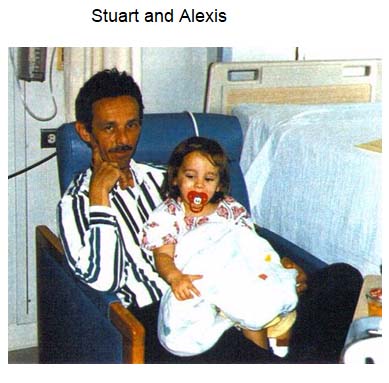

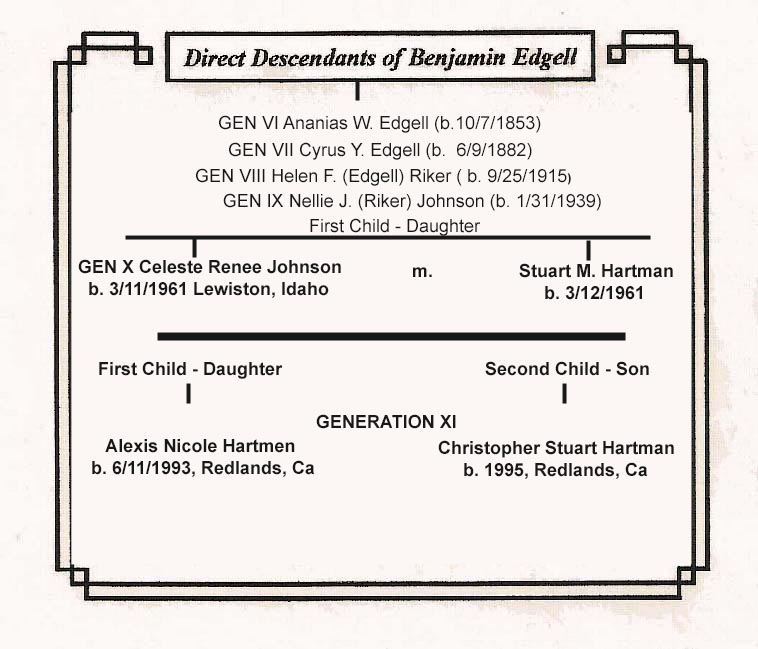
GEN XI Alexis Nicole Hartman b. 6/11/1993, Redlands,California
GEN XI Christopher Stuart Hartman b. 1995 Redlands, California
GEN X Patrick Neil Johnson, (Nellie's son)b. 12/11/1972 Spokane, Washington.
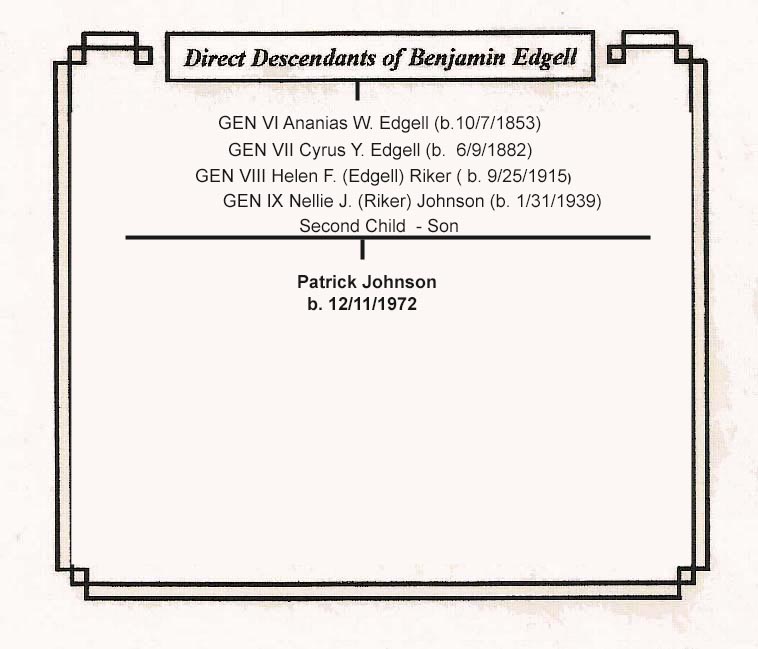
GEN X Rachelle Marie Johnson (Nellie's daughter) b. 11/5/1967 Spokane, Washington m.2/15/1997 Joakim Falth
GEN XI Brittany Lee Johnson (Rachelle's daughter) 4/23/1991, Father is Lee Elliot.
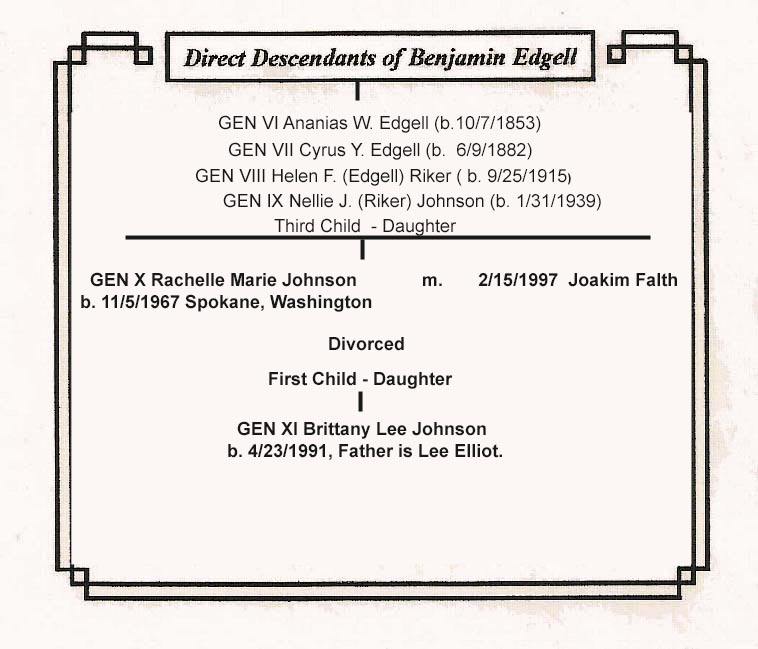
GEN VIII Kenneth Beryl Edgell (Cyrus and Sylvia's son) b.10/6/1917 Married Esther Copeland on 3/18/1942,
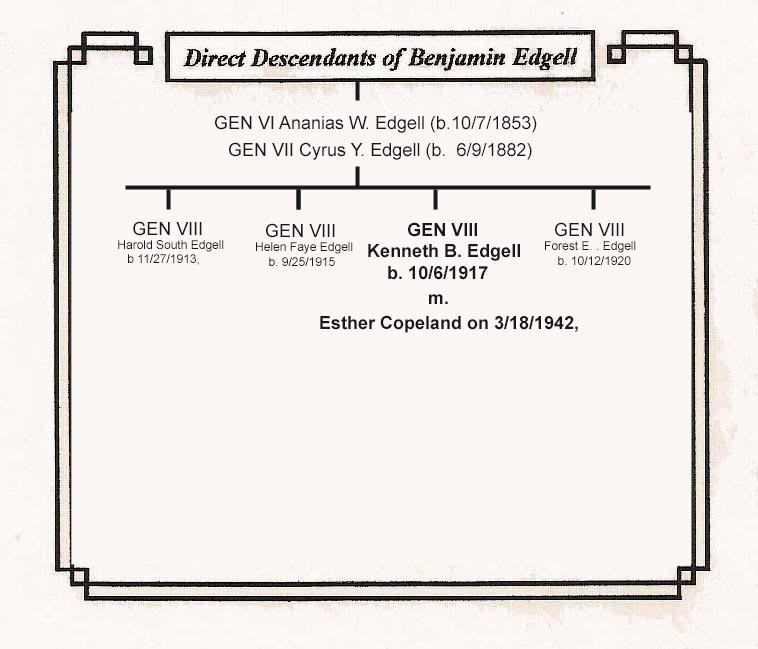
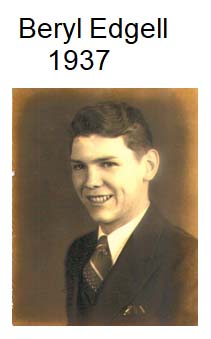
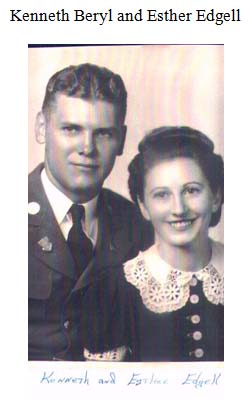
Kenneth Beryl moved with his parents to Colorado in 1923. Attended school
in Loveland but graduated his senior year at Goodland High School
(Goodland, Kansas). Kenneth was an officer in the U.S. Army (29th Division)
and took part in the Normandy Invasion, June, 1944. Kenneth died in the
invasion. In Normandy France a gravesite is marked with Kenneth Beryl
Edgell’s name along with the gravesites of thousands of allied soldiers who
took part in the Normandy Invasion. He died as a POW on 6/26/1944, Normandy
France. Robert Edgell, nephew of Kenneth Edgell wrote a historical novel
about Beryl's marriage to Esther and his time in the military up to his
death. As of this writing it is on the internet at
http://bedgell.com/Publisher/Beryl%20A%20War%20Drama.pdf
The family called him Beryl. He was the third offspring of Cyrus Yale and
Sylvia Edgell. We know from the chronicles of Forest, his younger brother,
that Beryl was an achiever and there was a very close bond between Beryl
and his younger brother Forest. Beryl was athletic. He was the quarterback
on the high school football team which achieved a co-championship season
for Northwest Kansas. When Beryl went into the Army, he became a 2nd Lt.
We see through the chronicles of Forest that Beryl was a man of character
with apparent leadership qualities. Before entering the U.S. Army, Beryl
fell in love and married Esther Copeland. Beryl’s older sister, Helen,
describes the relationship between Beryl and Esther as very loving and
Beryl adored Esther.
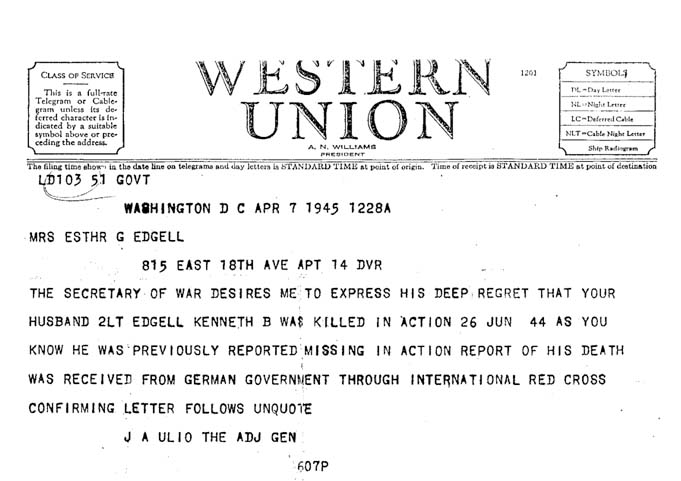
After the war, the American Battle Monuments Commission (AMBC) was granted, by the people of France, the land for the cemetery in perpetuity in recognition for the sacrifices in liberating Europe. Most of the soldiers interred in the Brittany cemetery died in the fighting around St. Lo and Mortain. The remains of the American dead were interred in France by permission of the next of kin. On the site is a memorial chapel and museum. Over the entrance door to the chapel is a sculpture consisting of an eagle, shield, stars, laurel and arrows representing the Great Seal of the United States. Below the sculpture is written:
IN MEMORY OF THE VALOR AND THE SACRIFICES WHICH CONSECRATE THIS SOIL


GEN IX Lois Sylvia Edgell (Beryl and Esther's daughter) b 4/18/1943, Goodland, Kansas.Married 1962 Walter Gorzinski b. 1/4/1940, divorced 1982. Two sons by Walter Gorzinski.
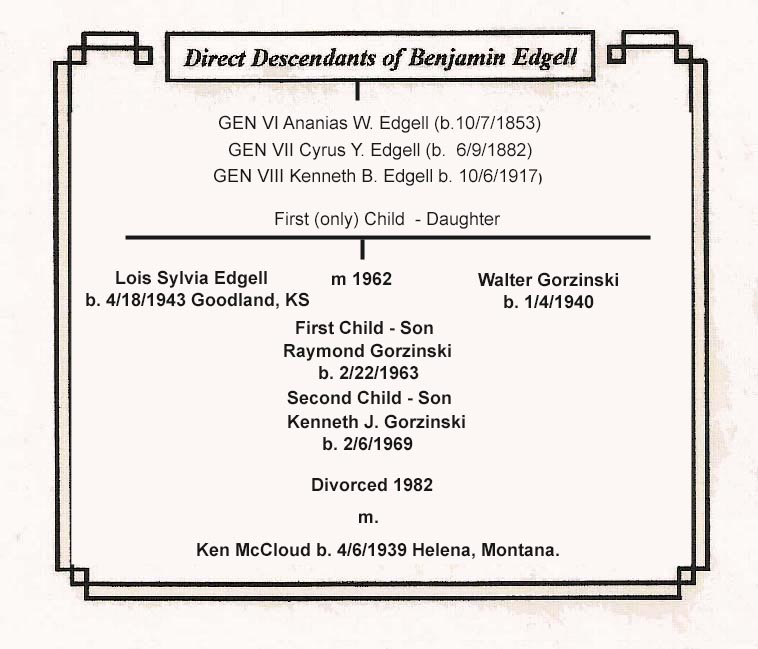
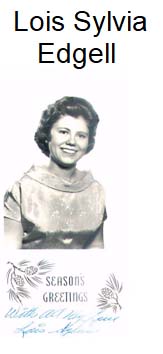

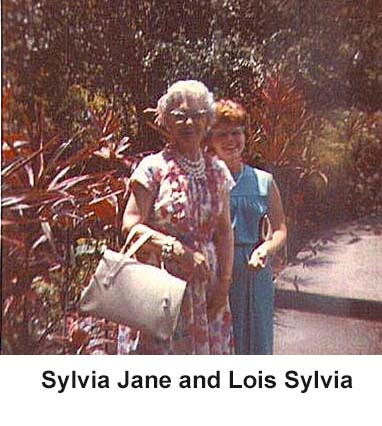
GEN X Kenneth Joseph Gorzinski b. 2/6/1969 Colorado Springs,
Colorado
GEN X Raymond Gorzinski b. 2/22/1963 Colorado Springs, Colorado
Lois Sylvia divorced Walter Gorzinski in 1982 and married Ken McCloud b. 4/6/1939 Helena, Montana.
GEN VIII Forest Earl Edgell b. 10/12/1920, Akron, Ohio d. 1998. Married 10/30/1938 to Lucille Irene Deves, b. 9/27/1920, Goodland, Kansas.
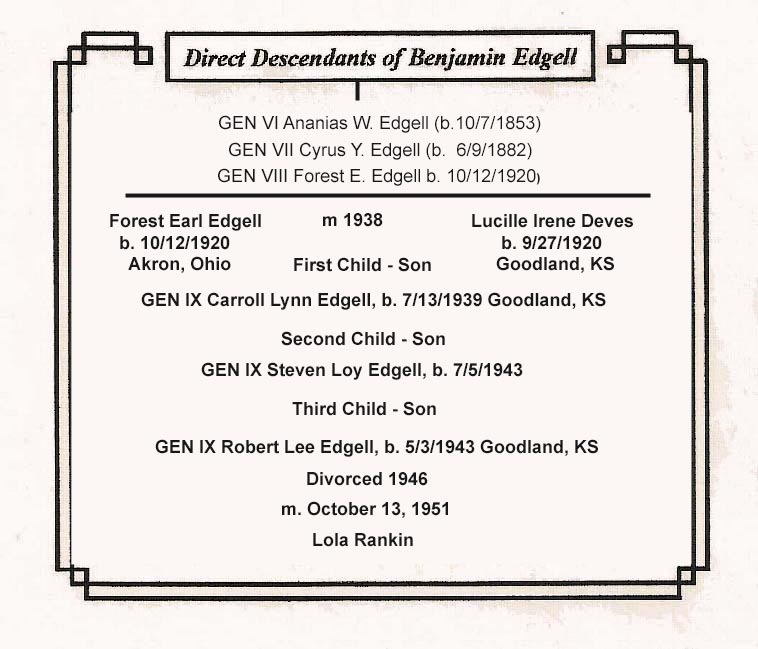
Lucille was the daughter of Joseph Gotthilf Deves whose roots go to
back to Martin Pagenkopf (b. 22 Nov 1799 in Kardemin, Hinter Pommern and
died in Shady Brooks, Kansas). Forrest and Lucille divorced in 1946.
Forrest remarried Lola Bell Rankin on October 13, 1951. Forrest and Lucille
had three sons: Carroll Lynn, Steven Loy and Robert Lee.
Lucille's life story and family photos are in a website dedicated to her.
The photos include the Robinson family, Edgell family, Amos family and many
more. When you arrive at the site, click on the 'Introduction' link.
http://bedgell.com/Lucille/lucille.htm
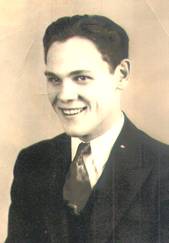

Forest's words from his Chronicles.
"When Dad was well enough he went back to work for a man by the name of
Forsyth whom he had worked for before. Dad was sent to Goodland, Kansas and
was there almost a year before Mom, Beryl and I moved to Goodland from
Loveland, Helen was married to Bill Riker at that time. Beryl and I made
friends pretty fast in a small town of about 5000 people. When we started to
school and got into football it kept us pretty busy. Beryl was the
quarterback and I played guard. We were Northwest Kansas CoChamps along with
St.Francis Kansas. Each team had lost a game and there was no playoff.
Dad was running a wholesale grocery that sold to stores in town besides
traveling all over Northwest, Kansas, St. Francis, McDonald, Atwood,
Oberlin, Norton, Colby, and back to Goodland. Beryl and I would help in the
summer an on weekends. Unloading carloads of sugar (100# sacks) handling the
sacks as many as four times we stacked them in the warehouse. We still had
time to do our own thing.
I met Lucille in school and started dating. We were married in 1939. I was
working at Horns grocery. After the war started I went to work in the
roundhouse as a pipefitter helper and was soon a pipefitter as they needed
someone on the graveyard shift. Lucille and I had three children, Lynn,
Steve and Bob. Lynn teaches school in Blair, Nebraska. Steve works for the
State of Arizona and Bob has his own business in Phoenix.
Lucille and I moved 8 times from the town we were married in until I went
into the Army. We lived upstairs in Grandpa Robinsons house, moved to a
renovated box car that had two bedrooms, a bath, kitchen and living room,
owned by her Dad ,Carl Deeves. We then moved to the Pink House on Cherry
that was owned by her mother, Mrs Baldwin.
I was drafted into the Army in early 1945 and was sent to Ft. Leavenworth
Kansas to get my clothes and shoes. From there I was sent to Camp Maxie,
Texas, just out of Texarkana where I was in boot camp. From Texas I was sent
to Cheyenne, Wyoming in the Engineer Corp. The war was over in Europe and we
were headed for the Pacific front. While I was in Texas Lucille wrote me a
letter and said she had met someone else and wanted a divorce. On the way to
Cheyenne I stopped in Goodland and started the proceedings. I spent six
weeks in Cheyenne working in the railroad yards. I was then shipped to Camp
Beale, California just out of Oakland, California. The camp was a
embarkation point for the war in the Pacific. Just after we arrived the war
was winding down so they put me behind a desk filling out papers for some of
the younger men before they were shipped out.
I was discharged on the 14th of December, 1945. I received my discharge
papers and $200.00. I still had a few dollars left out of my pay, so I sent
the $200.00 to Mom and Dad in Denver to keep for me and started hitchhiking
to Colorado. I hitched a ride with three Army fellows that were going skiing
up in the mountains, caught a ride with a rancher that lived back in the
hills, he dropped me off in the middle of nowhere when he turned off. He
gave me a tip and told me to walk about halfway up the hill, when a big
truck came along he would be in 3rd or 4th gear and be going slow when he
went past me. When he went past he motioned me to climb on board which was
easy to do as he was creeping up the hill. I caught rides with farmers,
truckers, and the last one was a salesman that let me off at Green River,
Wyoming. I caught a ride with another salesman into Laramie and took a bus
into Cheyenne and visited a buddy that was still stationed at Ft.Warren as
he was gone when I shipped out to California but nobody knew he was AWOL and
got lost in the shuffle. I got a ride with a Lt. that was coming to Denver.
I arrived on the 19th of December and surprised Mom and Dad as they didn’t
know when I was coming.
My brother Beryl joined the Army, infantry and became a 2nd Lt.. He was
killed in the Battle of Normandy Invasion on June 26, 1944 and was buried in
the Brittany Cemetery in France. He left a wife Esther and a baby daughter,
Lois Sylvia. This was a great loss to our family and I lost a brother and
friend."

"I went to Goodland to visit friends and see Esther and Lois Sylvia after Christmas. Came back to Denver and started working at Gates Rubber Co. as a stockman on swing shift, January 6, 1946. Mother and Dad managed an apartment house on 18th Avenue in Denver and after being discharged from the service I lived with them. Their apartment was small and I had a room in the basement. I met Lola while dancing at the Rainbow ballroom on 6th Avenue in Denver. Lola and son John had come up from Colorado Springs to visit her mother. We both loved to dance so we hit it off real well. Lola transferred back to Denver and worked at the old Montgomery Wards Building on Broadway that has since been torn down by implosion. John, Lola and I watched this from our front porch. Lola and I dated for about two years before we were married. We would go the drive in movies, picnics in the mountains and most everywhere we went we would take John curled up in the back seat. Lola and I were married October 13, 1951 in our front room at 545 So Pecos St. in Denver which is where we still live."
Forest married Lola Rankin who had a son, John. They were married until Forest died.
"Lola lived in a boarding house and the lady took care of John. After we were married she continued to care for John until he started to school, then I took over and was home when he got home from school. I accepted the responsibility of rearing John and he filled a void in my life. He was three years old when Lola and I were married. I gave him love and guidance as he was growing up. His natural Father had hardly been in the picture for years and passed away when John was 12 years old. John and I were always good buddies. I remember he received one spanking from me. He and the next door boy David were playing in the backyard. John had a beautiful metal truck and his friend wanted to play with it, and John though he was not playing with the truck would not let David play with it. I could hear the problem and because selfishness was something that I could not accept, John received a spanking. He still remembers this today. This hurt me more than it could have ever hurt him. John was a good student in school. After graduating from High School he attended The University of Colorado and after a year he joined the U.S. Navy, Submarine Service for four years. This was a lonely time for us as we wouldn’t hear from him very often when he was out to sea. We did get a chance to go see John while he was stationed in Hawaii. It was an enjoyable trip. After receiving an Honorable Discharge he went back to school and today is a Design Engineer for a company here in Denver. Seven years ago he found the perfect gal and was married to Rosemarie (Bunny). He now has two stepsons, Justin and Matthew."
After 32 years of not seeing his boys, Forest connected with his sons: Lynn, Steve and Bob. Forest hosted an Edgell family reunion at his home in Denver.

Left to right: Tom (and Laura) is Steve's son. Then Lola and Forest, Lynn Edgell and wife Ginger, Lola's son John Rankin, and Bob Edgell. In the middle are Sue Edgell, Bob's wife. Front row: Rob and girlfriend Amy. Steve and his girlfriend at the time, Carol.
GEN IX Carroll Lynn Edgell (Oldest son of Forest and Lucille) b. 7/13/1939 Goodland, Kansas Married: 1959 Carol Ann Hewitt b. Omaha, Nebraska. One Daughter, Shari Lynn. Lynn and Carol divorced and Lynn married Virginia Doosens. They had a daughter and a son: Suzanne and Scott.

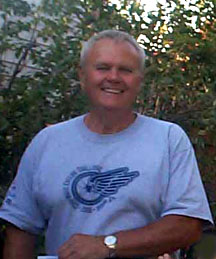
Lynn's own words from his chronicles:
"November 21, 1996 - As I begin this self-life-recording (autobiography) I
find myself a very contented seven plus fifty year old man. I use the word
"man" as you think I would, but still consider myself a little boy. In the
scheme of things and the order of the planets, I have only recently arrived
and still don't know what I want to do when I grow up. Currently, I am in my
27th year of teaching English to boisterous 7th graders in Blair, Nebraska,
a pleasant little hamlet of 6,000 situated 20 miles north of Omaha a mile or
two west of the Missouri River. I am happily married to Ginger Doose Edgell,
who can read my mind, and has been doing so for 30 years. We have two
children, Suzie, 25, who teaches junior high science in Norfolk, Nebraska,
and Scott, 23, who works hard laying cable and is still trying to find
himself. I find no quarrel with this, as it took me much longer to do the
same.
My earliest memory is climbing into bed with my mother, Lucille, and my
father, Forest, to read the Sunday funnies. We were living in a motel
somewhere near Colorado Springs, Colorado. I think my father was in the
service and stationed near there. Whether this was the influence that made
me into an insatiable reader, I do not know. It is just my earliest memory.
I was probably around four or five years old. Somewhere in the next few
years there was a divorce and I lived with two aunts.
Some of the time I lived with my mother's sister, Aunt Lois in Goodland, Kansas and later I was sent to live with my father's sister, Aunt Helen, and her husband Bill Riker in Loveland, Colorado.
Lynn returned to the family (Lucille, Steve and Bob) in about 1951. At the time, mom had remarried and lived with Tex Cochran and his 6 kids.
Volumes could be written about Tex. He was a jack-of-all-trades who moved when the fancy suited him. He thought nothing of uprooting the whole family, wife and 7 children, and moving in the middle of the week to another town or state. My earliest memories are of him are working a giant buffing and grinding lathe in his shoe repair shop ( I don't remember the town). I also remember being in a second or third grade class one morning and seeing Tex at the schoolroom door. He looked in and crooked his finger at me. I stood up, left all my books and supplies, and found myself the next day in a new school in a new town. I will give a short note about each of his other "trades." For a while he was a typewriter repairman. He could strip a typewriter or adding machine apart in the dark. One summer, My brothers, Steve and Bob, and I lived on a pile of our clothes in the back of a '49 ford. The passenger side seat had been removed and Mom sat on a five gallon bucket in the middle. We would pull into a small town and rent two motel rooms (one for Mom and Tex, one for the kids). Tex would go down the main street and pick up nine or ten adding machines from the local businesses. He would then go back to the motel, dismantle the adding machines, dip them in a container of gasoline, put on new rubber platens and ribbons and charge the owners $10. He then had $100 to keep him until he decided to work again.
For a few years, Tex owned a mattress factory. The factory was just a large machine and would fit into a garage. My Step-brother, Marian Dean, who was two weeks older than I, would assemble the mattresses and Tex would sell them. I helped when I could. We would make mattresses for a week or two until we had a truckload. Then Tex would drive around the country, calling on farmers who had just harvested their crops and sell them a new mattress and box spring. He guaranteed these Spring-Air mattresses for twenty years. He was in business for about five. One of my strong memories was moving in the middle of the night. Apparently, we owed money to many people in town. Tex backed the mattress truck up to the garage, hung blankets around the door to hide the light, moved our stuff out of the kitchen door into the garage and onto the truck. The next day we were 800 miles away and in another state, another school.
The one good thing about Tex I remember was the Christmases. Tex had a diamond ring that he could pawn for several hundred dollars. Every Christmas he would get four or five hundred dollars for it and buy all kinds of toys for us. He then would work for three or four months to get the ring back. It was his bank. I just remembered my first wife's maiden name, it was Hewitt. It is probably time to talk of my siblings. I have two brothers, Bob and Steve, one half-brother, Chuck, several step-brothers, Lee Jean, Sonny, Marian, Melvin, and one step-sister, Fay Ann. I haven't seen any of the step-siblings for more than 40 years.
Working from the list backwards, I remember little about Fay Ann except that she did hold her own against so many boys in the family. Whatever we did for diversion, she did. Melvin was the clown. If there was trouble to be had, he had it. An early recollection was of him hot wiring Tex's car and getting into a minor wreck when Mom and Tex were out of town. I heard that he became a truck driver and died in an accident in California or Alaska. Marian was his father's son. They thought alike and worked alike. When Marian and I were twelve, we worked full time in the mattress factory. I, however, was not allowed to do any of the skill work like sewing or putting in the buttons or handles. I could only load the cotton and springs into the machine. Marian could do anything that Tex could do. At twelve he was a man.
My full blooded brothers are Bob and Steve.
They are a much closer to each other than either are to me. They grew up together when I was living with our father and the two aunts.Around 1951 it was decided that we should not be split up and we all lived with Mom and Tex until about 1956 when Mom left Tex for the third and last time and we moved to Minneapolis."
"Steve and me during one of my many visits back to Minneapolis."
Miscellaneous photos from Lynn's chronicles.
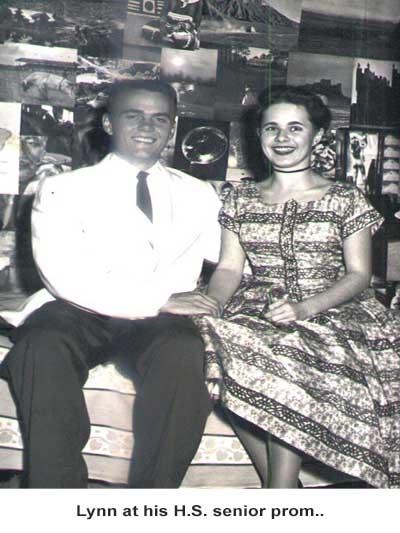


GEN X Shari Lynn Edgell (daughter of Lynn and Carol Hewitt) b. 10/30/1959 Minneapolis, Mn Married: Steve McCorkle, b. 7/6/1959 McCook, Nebraska. Two daughters and one son: Stephanie, Stacy and Sean. Divorced and Married: Dave Alton Walker b. 11/5/1958 Alexandria, LA.


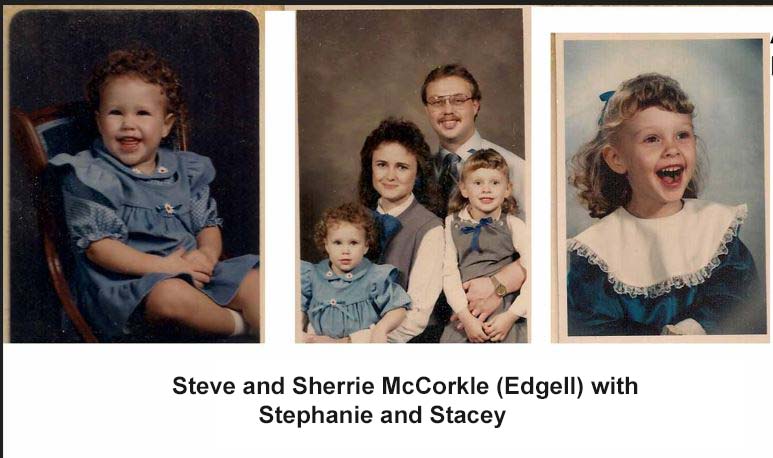
GEN XI Stephanie McCorkle b. 2/20/1981 Norfolk, Nebraska Married: May 20, 2005 to Joel Dieken, Norfolk, Nebraska. One son and one daughter.

GEN XII Ethan Christopher Dieken (b. 12-15-02) See Below
GEN XII Paige Jadyn Dieken (b. 12/5/2004) See Below
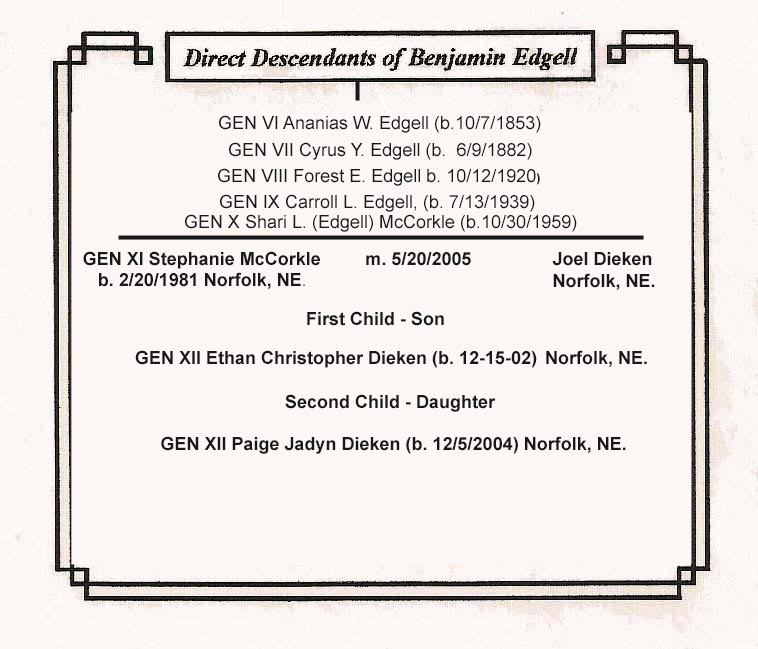
GEN XI Stacey Lynne McCorkle b. 11/25/1983 Norfolk, Nebraska Married 1/15/2004 Casey Cey Valdez b. 11/2/1979. Two sons: Brayden and Roman.
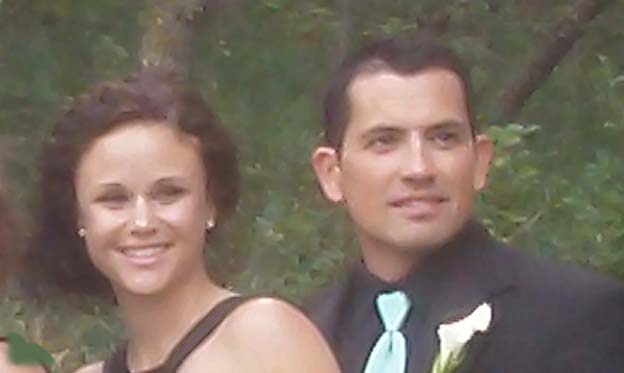
GEN XII Braden Valdez (b. 1/16/2009) See Below
GEN XII Roman Valdez (b. 12/5/2004)See Below
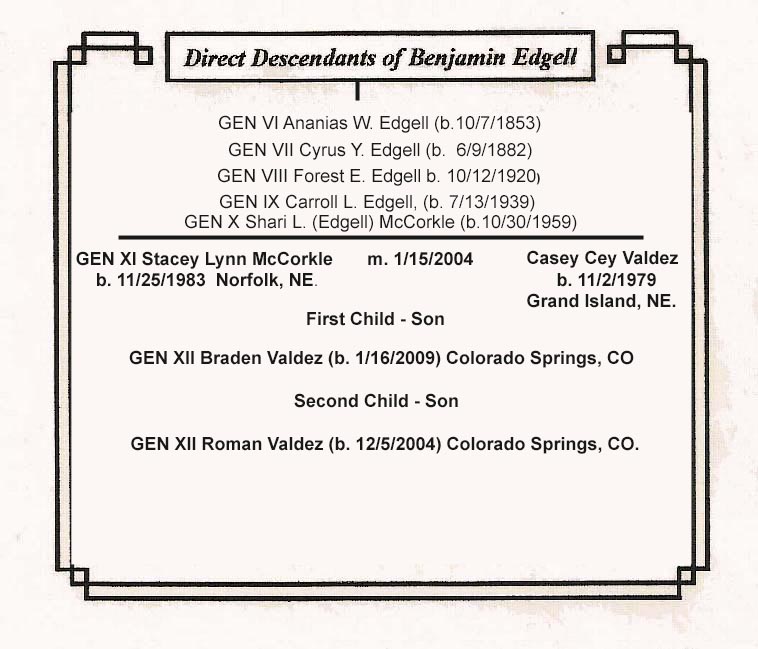
GEN XI Sean Paul McCorkle (b. 4/5/1989), Norfolk, Nebraska
Married:Mary Kathryn Back
Two Sons
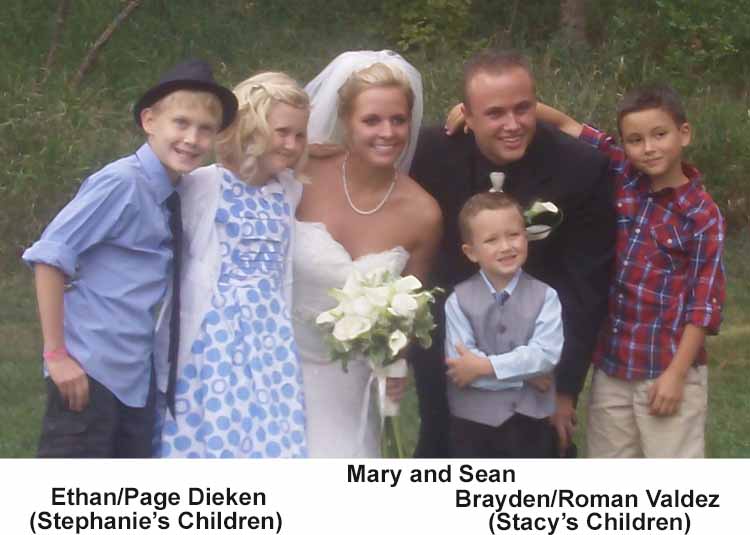
GEN XII Need Info Sean's son
GEN XII Need Info Sean's son
GEN IX Carroll Lynn Edgell, b. 6/13/1939 Goodland, Kansas (divorced his first wife Carol Hewitt and married Virginia Doosens) Married Virginia Doosens: Son Scott and daughter Suzie.

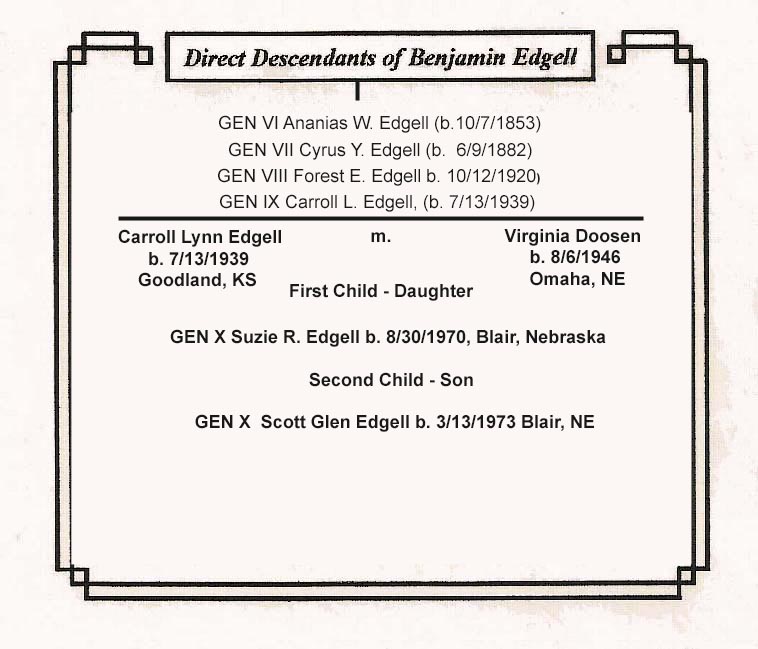
GEN X Suzanne Renee Edgell, b. 8/30/1970, Blair, Nebraska
(Daughter of Lynn and Ginger Edgell) Married (6/1/2002) Robert
Clarence Beeson Born :May 11, 1967 Norfolk Nebraska
Two sons: Mitchell and Andrew
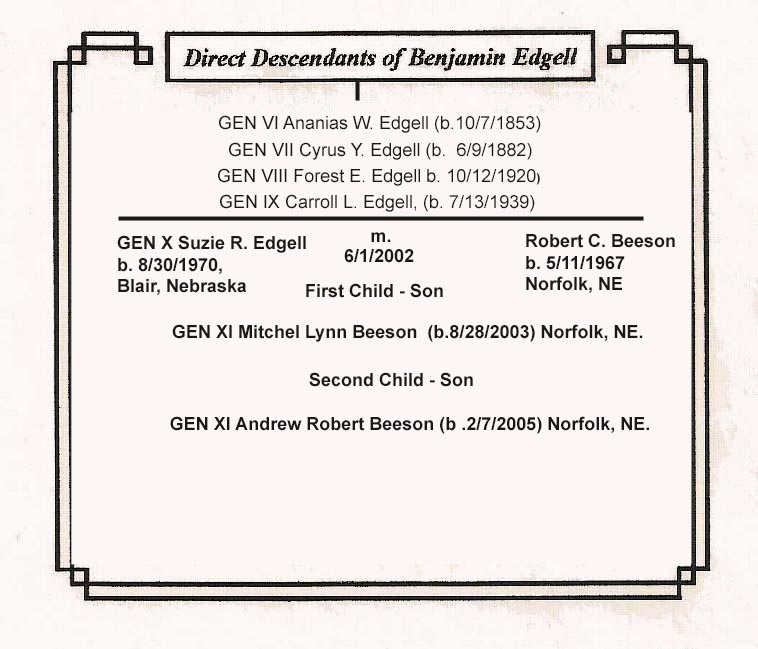


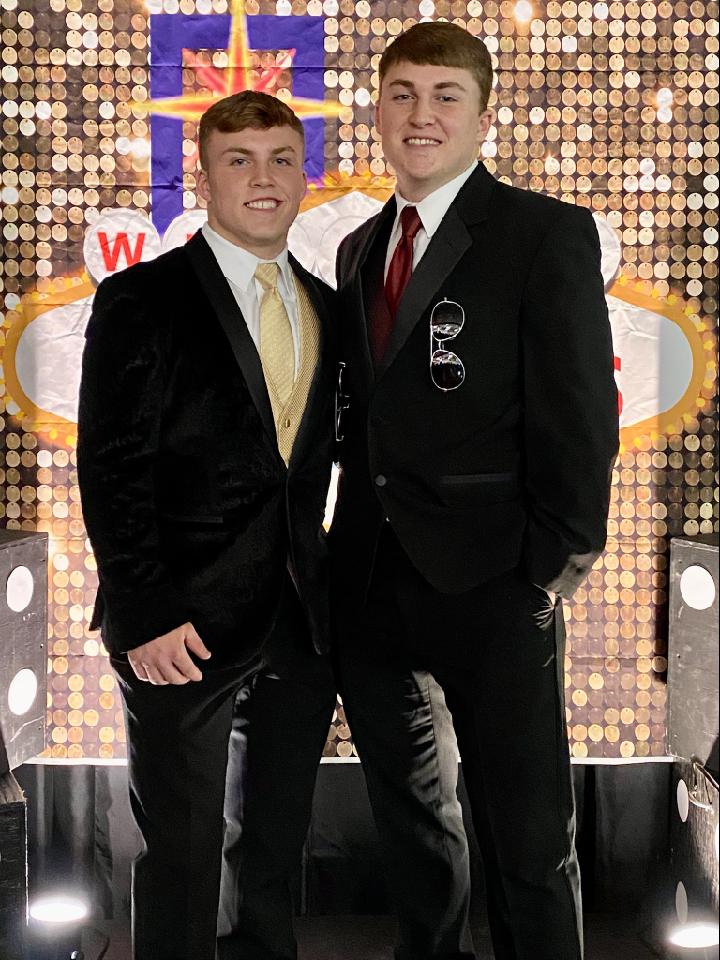
GEN XI Mitchel Lynn Beeson(b.8/28/2003) Norfolk, Nebraska
(on the right).
GEN XI Andrew Robert Beeson (b .2/7/2005) Norfolk,
Nebraska (on the left).
Andrew (Drew) graduated from High School in 2022 and on Friday, September 16 he played in his schools homecoming football game and was honored with the 'Homecoming King' crown.
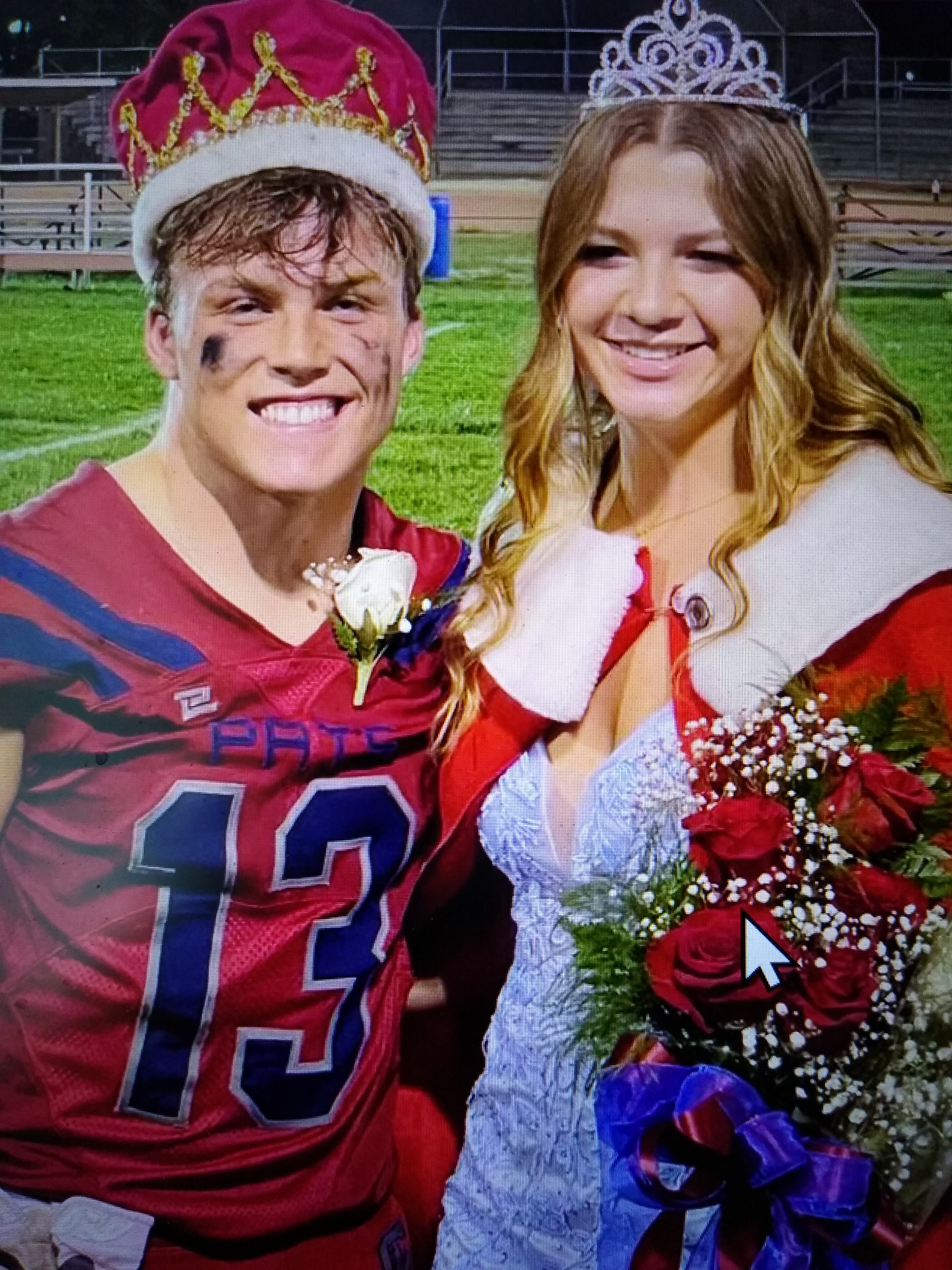
He also was instrumental in scoring a touchdown (as a
defenseman) in a 60 yard dash after a fumble by the
opposition.
Video
of the TD
GEN X Scott Glenn Edgell b. 3/13/1973 (son of Lynn and Ginger
Edgell), Married Angela Wulf b.
6/8/75 Blair Nebraska
Two Daughters: Chloe and Rylee

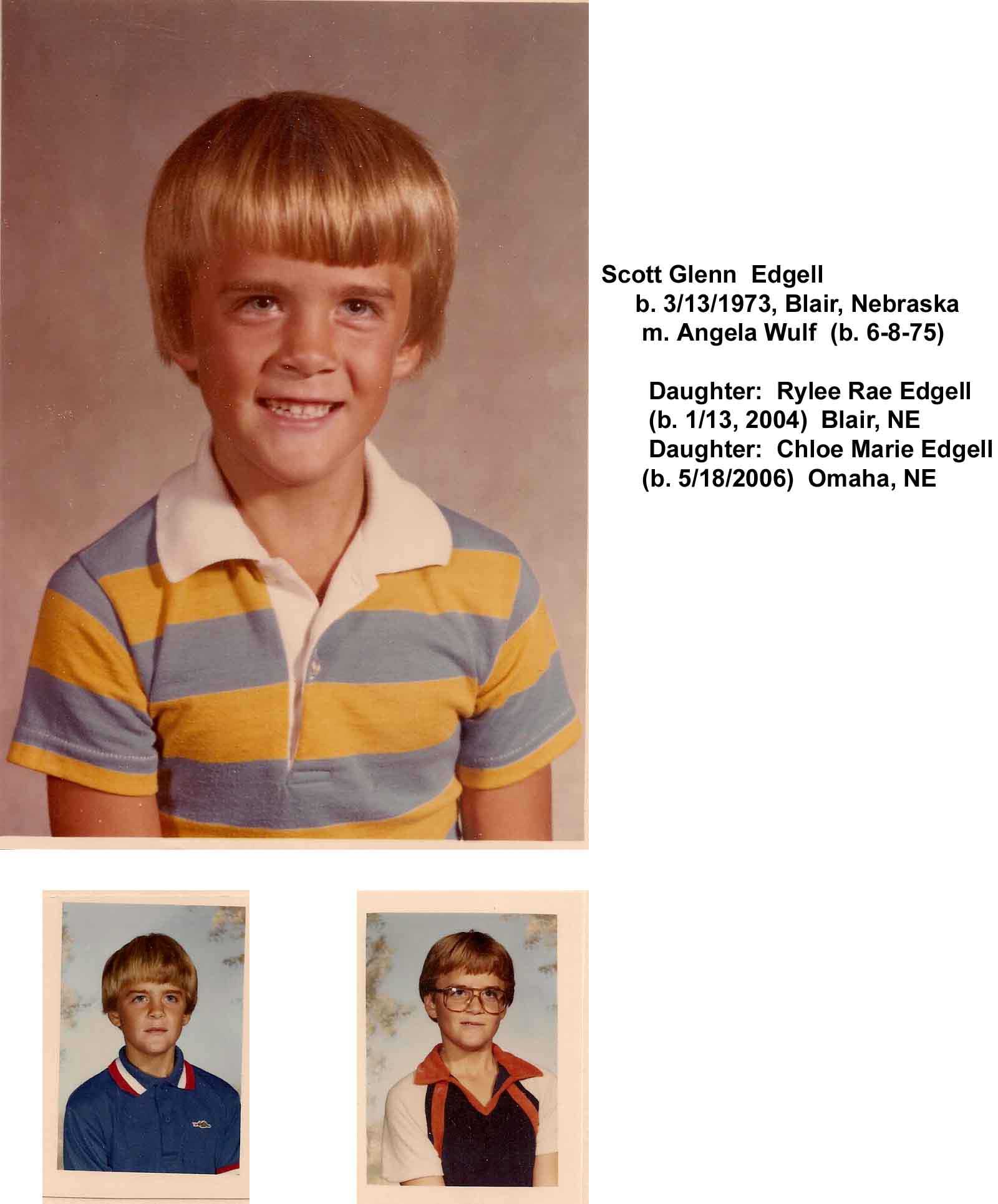
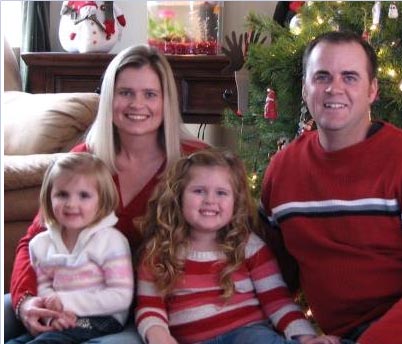
GEN XI Chloe Marie Edgell (b.5/18/2006 ) Omaha, NE

GEN XI Rylee Rae Edgell (b. 1/13/2004) Blair, NE
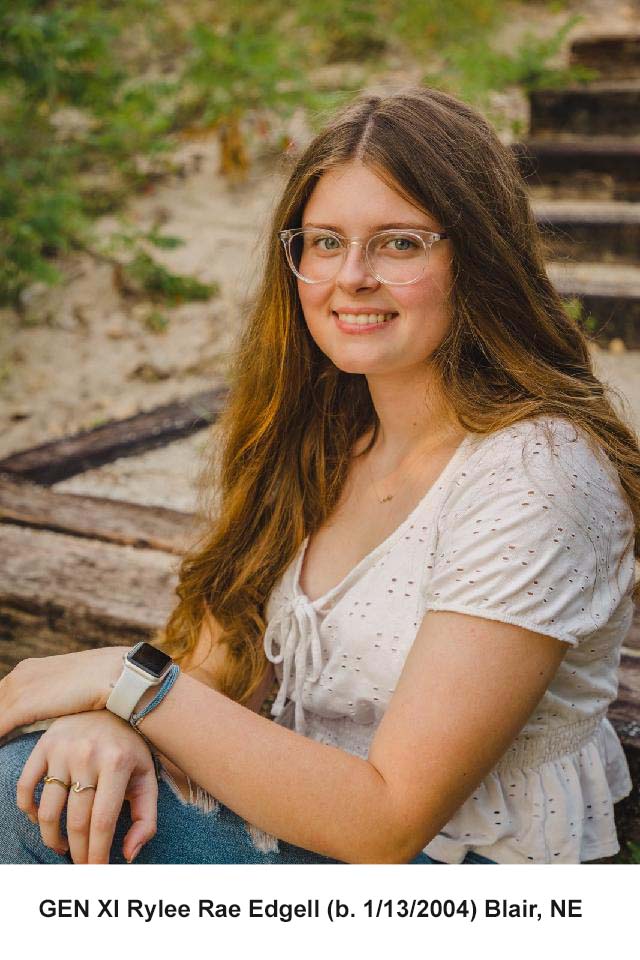
GEN IX Steven Loy Edgell b. 6/5/1941, Goodland, Kansas.(son of Forest and
Lucille) Married Mary Alice Carlson
One son
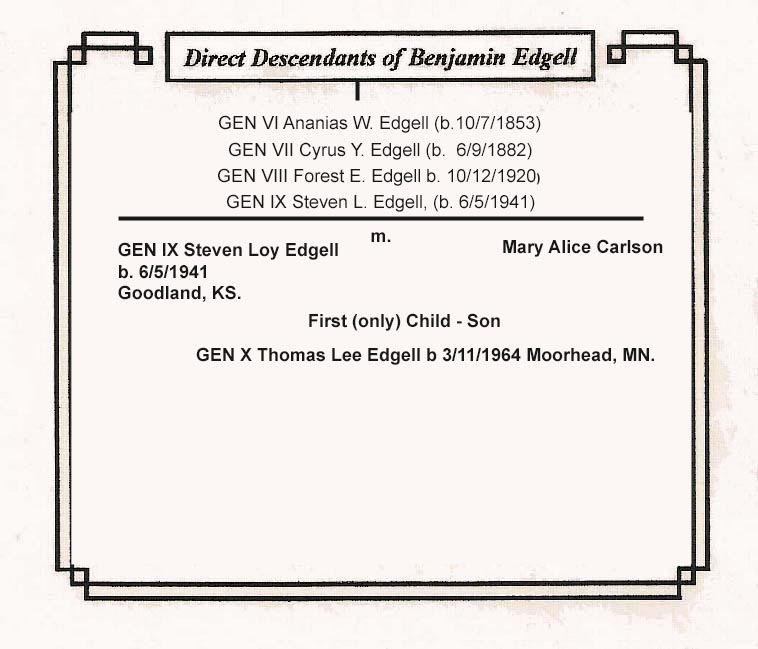


Steven Loy Edgell and Mary Alice Carlson

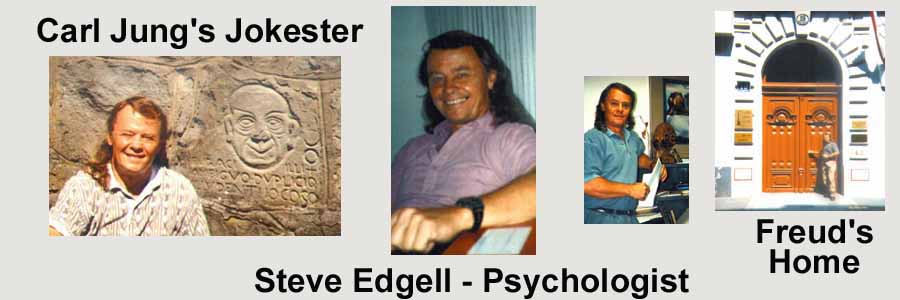
Steve wrote the following in his chronicle and everyone should read it.
"Allow me to start with a credit/disclaimer. The idea of this Edgell
Chronicles belongs entirely to my brother Bob Edgell. I’m sure everyone he’s
approached for a contribution has felt a queasy sense of reluctance wrapped
around ideas like: “I can’t write, I can’t let these people know how I feel
about them and I don’t want to know how they feel about me, Who really cares
about my story, I’m too busy,” etc. I know I’ve felt all of these and more,
but I think I understand what Bob is trying to do and this has helped me cut
through all of this hesitation and sense the value of the idea. It really
isn’t for us, but more for Edgells yet to come. For me, being challenged to
think through my own life events and relationships has been valuable. I’ve
done a lot of that before in my personal psychoanalysis, but never quite in
this form. I can certainly see the broader value in the collective whole
that the Chronicles promise. It should be a fascinating book to somebody out
there in the future as our tree spreads. I know that I’m looking forward to
hearing about you. Before I started writing my part of the “Chronicles” I
was able to read a draft of Bob’s entry and see his style of presentation. I
found it very interesting and well done. My style will be somewhat
different. His style worked well for him, but those things that I find
meaningful in my story require a different style from me. Like him, I’ll be
focusing on those people and events that, I feel, shaped the me that I am
being. Because of my beliefs about what influences us to be the persons we
are (described fully below) I’ll be a bit long-winded in the telling of
early life stories, and then drift to a more impressionistic/flashcard style
as I age along. I have decided to end my chapter at the point where I
graduate from High School. It’s not that I have stopped growing since then.
It’s just that my memories of stories start expanding astronomically after
that and there is no way I can do them justice in a proper amount of space.
Besides, the people who are around me now have lived around me for most of
these later years, already know most of the more recent stories and thus,
there are other references available.
Another disclaimer involves the accuracy of the memories that go to make up
these chronicles. Bob and I tell a story that, I think, illustrates the
potential for distortion. When we were very young and living in Lamar,
Colorado, we had an out-house toilet. Our stepfather once locked our dog in
there as punishment for some transgression. The dog fell through one of the
holes into the murk below and someone had to be lowered in to pull him out.
Because of the smallness of the hole, it had to be either Bob or me. I
distinctly remember watching him being lowered in and the trouble he had
with the slippery dog trying to bring him to the top. Bob tells a different
story. He remembers me being lowered down. Memories can be selective and
creative and perhaps none of the stories in these chronicles should be taken
too seriously. It could well be that we’re shaped more by the versions we
remember than by reality.
My life experiences and studies have left me tending to believe in a radical
form of environmental determinism, a sort of “environmental happenstance is
destiny” view, that will be shaping everything to come in this small chapter
of the “Edgell Chronicles”.
Believing this leaves me feeling like somewhat of a fake, sitting as I am
out on this tiny branch of the Edgell tree. A fake because, except for the
name, there is almost nothing about who I am being that has anything to do
with being “an Edgell”, at least in a cultural sense. I understand that
one-half of my genetic makeup is of that stock but, other than having a lot
to do with the shape of my physical body, there can’t be much about me that
is Edgell. I’m inclined to believe that the shape of my Self stems from
influences that have been almost completely Not-Edgell. As a fact this is
neither good nor bad, it just tends to be. I’m sure that I’m not the only
Edgell that this has happened to in the twigs and branches of the family
tree. Events like early life adoptions, deaths of parents,
separation/divorce of parents, etc., do amazing things to the spread of
culture in a family tree. I find this at least fascinating if not,
occasionally, a real positive factor that must be adding a lot of
interesting shape to the tree. The same genetic stock encased in a different
culture. In my case, the shift was rather radical from an English culture to
a German culture! To use a percentage value line (which should come in handy
as a device for shaping this story as I go along), I’d say that much less
than one percent of who I am has anything to do with the environment and
culture of the Edgells. An event happened very early in my life, at a time
before the personal and cultural influence of a father takes hold, at
approximately age three, that severed my Self from Edgellness. That event
was a radical separation from my father, and, I’m afraid, everything that
was going to be Edgell about me, but body and name. He went off to the war
and never returned.
For the first fifty years of my life I lived out of a story, I think, my own
creation, neither denied or confirmed by my mother, Lucille (hereafter
“Mom”), that my father, Forest (hereafter “Dad”) went off to the war,
experienced the wonders of a free young man in the exciting cosmopolitia and
couldn’t then face returning to the responsibilities of small town Kansas, a
wife and three small children (powerful story). I later heard another,
seemingly more believable story that mom met another man, divorced Dad, and
dad was never allowed to return (equally powerful story). If I had heard and
believed the latter story, my life and the shape of my Self would probably
have been significantly different. Truth probably resides somewhere between
the two stories. I did always find it interesting that Mom never uttered a
negative word about Dad; actually, very few words at all. She left his
reputation empty but intact. I had a few early-life contacts with him, and
in the past few years have established a warm relationship with him. I
enjoy, without regret, imagining who I’d be had things been different.
For the past Thirty-five years I’ve been training and working as a
professional psychologist and I’ve been overwhelmingly influenced by the
writings of earlier psychologists such as Sigmund Freud, B. F. Skinner, C.
G. Jung, etc., etc., and by my diagnostic and therapeutic probings into the
lives of my hundreds of clients. I’d estimate that this accounts for about
five percent of who I am (The percentage device again). I see this influence
as more of a tweaking of the shape of me than a primary shaping, and it
includes my own psychoanalysis, directed by me, but with the help of
numerous colleagues, students, clients and friends. I feel the same about my
power as a psychologist to influence the shape of the Selves of my clients;
at best, about five percent. Important, but quite limited. This leaves about
ninety-five percent of who I am unexplained. I’ll get to that, but first I
feel a need to offer some background of my beliefs as a context and
justification for this version of my story. My belief system has been
radically shaped by my experiences as a psychologist, but I had a
feeling/belief base well in place long before I started training for that
career. I believe that my early life had more to do with shaping me as a
psychologist than being a psychologist shapes me now.
At this point in my life, I have no contact with, and thus am disinclined to
believe in what Carl Jung calls the “Numinous;” spirits, god, gods, ghosts,
goblins, etc. One day, as a young boy in a relatively impoverished family
financial setting, feeling pretty sorry for myself for my lack of material
wealth, I decided to appeal to the god I had in place, and I prayed for a
bicycle. No bicycle was forthcoming, and this began the erosion of my belief
in a sympathetic god (and, who needs to believe in an unsympathetic one?). I
now realize this wasn’t a fair test, but I’ve never since been able to put a
god back together
I have, since the age of seven, been blessed with the general feeling of
liking myself, and since that time, even during the roughest of times, been
able to look back on my life and not want to change a moment. This feeling
is probably supported by some denial and repression, but it has served me
well. Somewhere in my seventh year I suffered a major crisis of faith. My
teacher at the time sent a note with my grade card saying “This boy is
suffering from emotional problems.” What I was feeling was a deep sense of
inferiority, shame, and a feeling that I was slipping into nothingness. Mom
caught me in free fall, sat me down, and convinced me that I was “...just as
good anyone else”. Brief therapy, indeed! I took it literally, have never
doubted it since, and it is lodged as the cornerstone of my faith and moral
tendency (though not necessarily my behavior). Thus, as I relate details
about the various characters in my story, some of their behaviors may seem
good or bad, but I do tend to believe that, as people, any one of us is as
good or bad as the other.
The most serious challenge to this position came from my grandmother Leila
(Grandma), who, for many years, I considered a saint. In everything she did
with me, she demonstrated the extreme of the potential goodness of people.
She left me feeling that I had a very special place in her heart, and that I
had a powerful effect on her emotions. She was a highly religious,
emotional, and other-directed woman, tending to worry and fret about matters
of her and others’ health, finances, or anything that might upset anyone
around her. From my earliest days, anytime I might catch her in a fretful
mood, I could stare at her until I caught her eye, and with a little smile
of my own, transform her frown into a smile. What power! What a gift from
her! Again, brief therapy. I’m still left with the belief that I can
transform others’ moods. I felt, at the time, that I had a special
connectedness to her, and, had she been around more, I would never have had
a crisis of faith (but, alas, neither would I have had all the wonders of my
present cosmology). I understand now how hard it can be on a soul to try to
be that good and self-denying; an impossible position to maintain given the
basic nature of the human be-ing.
Still somewhere in my third year another event happened that would overwhelm
my budding Self and the process of individuation. That was the introduction
into my life of Robert Cochran (always “Tex” to us) who was soon to be my
stepfather. Freud teaches us that it is a typical experience in the life of
a young boy between the ages of three and five, to peak in their lust for
their mother and rivalrous hated for their father. If Father is of
sufficient psychological strength relative to the mother the boy will feel
severely threatened by the father (Freud called this castration anxiety) and
will thus retreat from both emotional peaks, learn to repress such feelings,
and go on about the business of being a little boy doing little boy things.
Freud calls this whole process the Oedipus Complex. It serves to properly
wean the child (especially a male child) from mother’s influence, allowing
him to begin to develop masculinity through identification with the father.
I must have enjoyed a short period of Oedipal victory when my real dad left
for the war, perhaps feeling like I had defeated the hated rival, but it was
to be short lived, as Tex almost immediately filled the void. He served
quite well in the “separating” half of that role of “Father” for me during
my Oedipal phase, though his role as a masculine role model for me to
identify with was undermined as described below. My earliest memory of him
was while playing with my brother Bob on the steps leading to our apartment
at grandma Lelia’s house in Goodland Kansas. He opened the door and came
bounding down the stairs. As he passed he tousled Bob’s hair and said, “How
ya doin Butch?” The nickname “Butch” stayed with Bob until he outgrew it
some fifteen years later. My first impression of Tex, foreshortened because
I was sitting down and he was on a higher step than me, was of an extremely
tall, thin (lanky), energetic (I think I remember him taking the steps two
at a time), very handsome, all-male man with a beautiful smile. I must have
felt tremendous castration anxiety, as there was no way I could compete with
this creature for my mother’s affections. I now consider his presence an
amazing stroke of luck, though at the time I must have been devastated,
given his potential for so cleanly and thoroughly separating me from Mom.
There must have been a period at about that time where I was left free
falling in psychic space barely attached to anyone. I’ll get back to that
shortly. Tex had a tremendous influence on the development of my Self,
perhaps accounting for about five percent of who I am. As it turned out,
this became a negative-reactive influence and there is very little about me
today that resonates in identification with him. The reason for this seems
to be that, while Mom fell completely (maybe primarily sensually) in love
with him, it was short-lived and rather quickly turned to an ambivalent
love-hate/on-off attachment that made it impossible (even dangerous) for me
to identify with him. As I aged along it became necessary for me, if I was
to stay close with her, to hate him as much as she did. I was able to pull
this off for many years until I got into my own analysis. My failure to
co-pretend this hatred with her in her last years put a tremendous strain on
our relationship.
Mom had an experience at about age sixteen that seemed to have set her
relations with men for the rest of her life. At that time she was perhaps a
bit overly attached to her father having had a special place in his life,
being the younger daughter and helping him out at his cafe in Goodland. One
day she was delivering pies that her mother had baked to the cafe for him to
sell to the customers. He had a cot in a back room and she walked in on him
and another lady of the town. This experience seemed to have destroyed her
ability to trust men and was more upsetting to her than to her mother,
though her parents divorced a couple of years later. She may have carried
these feelings into her marriage with my father for she did claim to have
never been much in love with him. Tex managed to burn through this
distrust/hatred complex for a while but it wasn’t his nature to be very
trustworthy as a mate and when she finally left him “for good” about ten
years later she never really softened to a man again. She maintained a
hatred for Tex and a fear that he might return until the day she died. I
always felt that there was more ambivalence in her feelings than this,
perhaps even an attraction, but any suggestion in this direction was met
with intense anger.
As I said above, Tex’s influences on me seems to have been born more on
negations than attractions (though I might have been more attracted than I
dare notice). He did have a strong influence on my theory of health. I have
found that everyone has a theory of health and wellness stemming, I believe,
from cultural influences; partly shared with those around them but, always
with a few secret ideas and remedies of their own. Sicknesses and remedies
tend to run in families. In the Postmodern view this is being largely
attributed to genetics but I don’t believe it will be long before we realize
that all disease is born on psychological struggle; socially shaped. In his
novel, Erewhon, Samual Butler places his main character in a mythical land
where crime is treated as a sickness and sickness is punished as a crime. In
this land there is very little sickness. As a follower of B. F. Skinner I
have to ignore Butler’s remedy (I don’t believe that applied punishment is
ever justified or effective) but his story leaves us considering the
possibility that sickness is not inevitable and that the forms it takes may
be more symbolic than real. In my early family the diseases of choice were:
“Colds”, “The stomach flu”, “Hay fever” and “Headaches”. We never heard of
Asthma or other exotic diseases found in other families. In my theory of
sickness we teach our children to “Play” with microbes: viruses and
bacteria. We shape them into Asthma, allergies, and headaches and, as they
age, into arthritis, heart disease, cancer, etc., by the way we respond to
them individually and as a culture. In a diverse and blended culture like
the United States and my family the sickness thing can get very interesting.
I remember Tex shaping some of my sickness behavior very early in my life.
With up to ten of us sharing a small space and with the theory in place that
“To contact is to catch” one kid coughing soon led to eight kids coughing. I
can remember laying in bed, taking my turn, coughing on cue, with the theory
in place that my coughs were a compulsory, natural and inevitable result of
my sharing some sickness with the rest of the family, only to be rudely
directed to another theory by Tex barking out “Steven Loy, stop coughing”
(Steven Loy was what he called me when he was upset with me). To my
surprise, I was easily able to do so. I learned then and there that we can
develop skill in managing our relations with microbes. I still get sick,
about an average amount, but a bit of probing always seems to reveal other
meaning and value.
Freud had a bit more to say about the Oedipus complex (described above)
that seems to apply to my story. He said that if the child perceives an
emotional gap between the parents, he might be heartened to attempt to find
ways to maintain his mother attachment. I remember one such ploy on my part
(though, I believe, unconsciously motivated). I “wet the bed” until I was
about six years old. Tex could be quite aggressive and physically punitive
with a child if he didn’t like a particular behavior, but for some reason he
was tolerant of this behavior in me, and it allowed me a tiny special place
in Mom’s emotional concern. I can remember both of them working together to
try to figure out ways to correct the problem. I can’t remember any of their
theories or solutions, but I don’t think any of them were particularly
punitive. There were more serious consequences with my siblings. We were not
wealthy and at times all eight of us children slept in one or two beds. I
can remember waking up in a morning in the middle of the bed, in a bath of
pee, with a ring of siblings sleeping on the outer edge of the mattress.
These were not popular times.
Other than this tiny space, I was pretty thoroughly separated
sensually/emotionally from Mom by the introduction of Tex and the addition
of his five children to our family (Lee, Sonny, Melvin, Marion and Fay, in
downward progression of age), and the failure of my little Oedipal game
(described above). I was left unattached, free- falling in psychic space.
The fact that there were now eight of us children left little of Mom’s
emotional energy available to me. I must have been desperate for attachment.
My older brother Lynn might have been a natural choice but he was
unavailable at that critical time, having been sent off to relatives; I
guess, to make room. While he did return physically a short time later, I
always felt that he was never able to completely re-attach himself to us
emotionally. The next logical choice was my younger brother Bob; and, attach
to him, I did. I’ve always silently explained my small stature (five foot,
six inches tall) as a result of my efforts to join Bob at his level of being
during the growth years.
Even though he is two years younger, we were often taken for twins and
that was comforting to me. I fused with him and we were inseparable for the
next decade or so. I’d estimate that about fifteen percent of who I am stems
from a cross identification with him. A rough and general remembrance of
those years has him and me flying along with this amazingly blended family
of ten, like a caboose on a train, from town to town, barely noticed by the
other members, left on our own to build an ongoing chain of active
fantasies. We were out of doors, by ourselves, most of the time, though we
had enough contact with the other members that I can remember many
interactive stories about each one of them. Bob and I played “little cars,”
“Cowboys and Indians,” “Cops and Robbers,” and many other spur-of-
the-moment games from dawn to dusk in what I remember to be a perfectly
blended, co-creative exchange of ideas and fair-share, take-turns changes of
roles (who got to be the good guy, etc.). I was two years older and, given
the way he defends himself against my influence these days (No more, of
course, than I defend against his influence), I must have forced a distorted
brand of “fair-share” into the games, but I don’t bother remembering it that
way. Only rarely did anyone else enter into our games, but our older brother
Lynn did have an occasional role.
The identity space between Lynn and me has always been wide, and I’ve
never been able to bridge it for long. He was always many more years ahead
of me than the two that actually separate us, (perhaps because I went
backward to join Bob), always wiser in the ways of the world, and much
better read. He never seemed comfortable actually engaging in the level of
play that Bob and I shared but he was way ahead of us in fantasy. He would
occasionally join us as a sort of fantasy consultant, teaching us how to
structure our roles, build our settings and props, and give us lines to
bring our characters to life. It was like he would build the castles and Bob
and I would play in them. Last I heard, he was still doing this for the
children of Nebraska. Bob and I would play through his creations for days,
weeks, months at a time.
The literature at the time was comic books and the theater was the
Sherman Movie Theater in Goodland, Kansas. He taught us how to use this
media to build self and character. He had a particular identity with Tarzan,
maybe particularly Johnny Wiesmuller as Tarzan, and his nickname for many
years was “Tarzan.” I think what made Tarzan so good for him was what he
could do with his imagination with the idea of an ape-man, a free roaming
feral creature tied to the animals, with all of the wisdom of a scholar, and
the power of the “Lord of the jungle”. If there is a touch of rebellion to
civilization and established male authority in this, it was never openly
obvious outside of his play. If you played Jungle with Lynn you had to be
either the “bad guy,” “Jane,” or “Cheetah.” I can remember toying with all
three. Lynn had little tolerance for being the “bad guy.” I remember one of
his creations where, as a cowboy, in a white hat, he would walk into a bar.
The bartender would ask him what he wanted. He would respond, “Milk.” A “bad
guy” in the corner of the bar would chuckle. For this act of insolence, Lynn
would pull his gun and shoot him. Bob and I reenacted this scene countless
times. Lynn was a deeply moral and righteous boy extreme in his masculine
protest. He blazed the trail through latency for Bob and me, and we were
able to pick and choose from his teachings. I am neither as moral nor
masculine as he.
While Lynn was learning to be a teacher in that early setting, I was
learning to be a psychologist. I make my living crawling into other people’s
sandboxes and helping them recreate their castles and characters. I was a
middle child and that forced me into a variety of roles and experiences.
There were three of us, and if you break that down into the natural sets of
two, I spent time as the oldest and the youngest. I probably managed some
time as the only child. Mom used to talk about sending us off to do a chore;
“You two youngest...” or “You two oldest....” I can vividly remember the
shifts in me when I was alone with Lynn compared with when I was alone with
Bob. My favorite example is when outdoors at night with one of them. If
alone with Lynn, I felt small and afraid but at the same time protected. If
alone in the same setting with Bob, I felt strong and protecting. This had
the effect of not only spreading my personality and sense of role, but also
my ability to identify with the positions and defensive structures of the
various roles. Arbitration became a natural talent for me, and I frequently
found myself either helping two of the others settle their differences or
taking advantage of the fact that there were differences. I can particularly
remember spending time between Bob and Lynn, Bob and my stepsister Fay, Bob
and our younger brother Chuck, and many others.
One very unique thing for me about the blending of the Edgell and
Cochran families was that, at that tender age, I suddenly had a sister
(stepsister) the same age as I. I don’t think Freud had much to say about a
scene such as this. She didn’t come with a set of instructions. I had to
wing it all the way. I now find it interesting, from an avoidance point of
view, that I didn’t attach myself to her; that I chose Bob instead. She was,
after all, my age, pretty, and a fascinating new entity in my life. I now
know that fascination is a luxury emotion. I now consider it to be my second
favorite gift. My favorite gift has been curiosity. I may have been too
afraid to sense the presence of either at that point in my life. I also
know, that at that time, she was the youngest in her family and the only
girl of the combined bunch. I suspect she was getting all the attention she
needed, and, thus, there was insufficient point of identification. I always
felt a protective fondness for her, but we had little in common. She was
always more of a threat to Bob as he was the youngest of our side, and they
often competed for the same emotional space. For the next twelve years, with
a break of four years in the middle (described below), right up into the
middle of our puberty, she was right there aging along with me, sometimes in
the same school class though usually not. It might have been good for both
of our budding sensualities that we were separated when we were. It is
interesting to me that she was present during all of the non-Goodland
stories below with her influence blended into those formative times.
Freud calls the next decade after the resolution of the oedipal complex,
the “Latency period”. It lasts from about age five until puberty, and, as
stated above, if properly resolved, the child is desexualized, (represses
all notions of lust and hatred), learns to convert emotional energy to
learning and age-mate play, and “goes on being a little boy doing little boy
things”. We spent this entire period in an on-again, off-again mixture of
the Edgell and Cochran families. There were roughly two periods starting at
about age four, and I’ll get to those shortly, but first allow me to muse
through the few preoedipal trace memories I have.
The first four years of my life were spent in Goodland, Kansas, near
Grandma, with other main characters being: Mom’s older sister Lois (her only
sibling), Lois’ husband, Bob Amos, and my step-grandfather Olda Baldwin
(Grandma did remarry a short time after she left Mom’s father, Carl Deves).
I have a few faint memories of my great-grandfather Robinson who lived with
us in grandma’s house. He must have been an interesting character but I came
into his story very late during his last few presenile years. Almost all of
my memories of him were of him sitting in his rocking chair in Grandma’s
basement. I remember the smell of his pipe, his leaning over the left side
of his chair to spit in his spittoon, and my staring at him for long periods
of time without getting any response in return.
Other story stems from that period include:
• Bob and Lois Amos building a house next to Grandma.
• Brother Bob getting caught with Uncle Bob’s wallet.
• Falling off of Lynn’s “Piggy back” and cutting my eye.
• Grandma in her flower garden.
• Olda dressed as a railroad worker with his black lunch pail.
• Lois telling me that I could not have any crab apples because, after
checking the skin between my fingers, she decided that my skin was too
sensitive.
This last stem deserves a bit of elaboration. I never quite trusted or
properly respected Aunt Lois. She was a natural role figure as Mom’s older
sister, but I always felt that there was a lot of strain in her trying to
fit into a class (the happily married woman with a nice husband and special
kids) that was higher than the class in which we were struggling along. I
took a strong lead from Mom in finding the little flaws in her presentation
and was never able to (still not able to) aspire to that “very middle class”
sort of lifestyle that was so important to her (I learned a lot about
passive aggression in these little sharings with Mom). We should have been
closer because my middle name (Loy) derives from hers. She died at a very
young age, brokenhearted when her marriage failed. The distance I felt
toward her was transferred to her husband Bob Amos. He is the only Uncle
I’ve ever known, and, thus, should have had a strong influence on my
masculine identity. I don’t remember sharing any personal/intimate space
with him during those formative years. He’s never refused me anything and he
has been there for me on a couple of important transitional occasions. When
I was about sixteen he took me along on a family vacation from Minneapolis
to Goodland through the Black Hills. He allowed me to drive his old Plymouth
(three speed, column shift) and thus actually “taught” me how to drive. When
I left the Navy he offered me a job and trained me as an Insurance Sales
Agent for his agency. He was an agent himself and sales was his life, a
natural talent, but it was not me. I dropped out in less than six months.
The first of my two intra-latency periods (after age four) lasted for
about four years and involved moving from town to town with the blended
families. I’m going to be more impressionistic from now on. By my figures, I
only have about five per cent of my Self to account for in all the rest of
my story. Our first act was to pick up Tex’s children at an orphanage where
their mother, Edith, had left them. Tex had a very strong attachment ethic
and sense of responsibility to his children. Our first move was to Roswell,
New Mexico, where we lived for about six months. We lived there during the
famous Roswell UFO incident, so there could be something extra-terrestrial
planted into the family tree. We also lived there during the first nuclear
bomb testing, so there could be some interesting mutations blended in. We
lived in a farmhouse about a mile from town, surrounded by corn and alfalfa
fields. A few story stems from that period include:
• Tex almost accidentally shooting a neighbor while practicing.
• Cut and sliver from the outhouse door.
• Sexual play in the shed.
• Huddling in bed with Mom and all during a lightning storm.
• A trip to Binkleman, Nebraska.
• All ten of us sleeping on the floor of a garage at a motel.
• Primal sounds and smells.
• Waking up to our first dog Laddie.
• The old car with the missing fender.
• Rocking the outhouse as a practical joke.
• Forbidden play in the cornfields.
• Being told about being at war with the Japanese. At first thinking
that they were bugs and being horrified when I found out that they were
people (this may be in the roots of my pacifism).
Following along on the theme of school through the next few years, there
were some tendencies (I will get back to the chronology after that). I
remember particularly the attachments I formed. While my attachment to Bob
was always strong at home, I always had three (and never more than three)
other very close attachments: one, close and friendly; another, secret and
known only to me; and a third, close, but unacknowledged. First, I always
had a best friend, another small introverted boy in my class to whom I
became attached for play and emotional support. This tendency lasted all the
way through high school. Some names I remember are: Jerry Hargraves, Gary
Lindsey, Pat Hallisey, Tom Greimel (the namesake for my son), and Pat
Riordan.
There were several others. Second, I always had a secret girlfriend, a
girl my age or slightly younger to whom I felt an undeclared sensual-fantasy
attachment. I don’t remember any of their names except Rosemary Shores. The
third attachment was a special relationship with all of my teachers. I was
never the teacher’s pet, but very early in my school career I developed a
gift for shaping a teacher to never call on me in class. The technique
included sitting in the middle of class, looking miserable and ashamed, and
never earning more or less than a “C”. It was as if I disappeared.
Back to the Chronology. During that first grade year (I didn’t do
Kindergarten), we moved to another house in Lamar that we called “The
Basement House.”. The owner had built a cinder block basement and covered
the floor of the first story over with tar paper. We lived there for about
two years and many stories were generated (though none on the house itself):
• We had indoor facilities.
• Fay had her appendix out.
• My half-brother Chuck was born.
• Mom “fell out of the car” and was badly bruised.
• So many of us that we had to eat in shifts.
• Letting Bob get punished for something I did.
• Learning to ride a bicycle.
• Celebrating Halloween a night early.
• The fading of belief in Santa Claus.
• Tex owning typewriter shops in Lamar and La Junta.
• Getting caught by Mom and Tex for not “Quieting down and going to sleep”
when I thought they had left.
• All of us getting punished for playing with matches on the steps.
• Old lady “Mustard Eater.”.
In the summer between my second and third years of school, we moved to
Scott city, Kansas, where Tex had purchased an unfinished two-story house on
an unlandscaped yard. The house and yard stayed this way as long as we lived
there. He worked as a Cobbler for this year. He was very handy with his
hands. I remember him coming home one evening after work complaining that he
had only made five dollars that day. I thought that was a lot of money. I
don’t remember much about that year. I must have been lost in a fog as that
was the year I was reported as having “...emotional problems.”
A couple of faint memory stems include:
• Learning a Spanish phrase from our pretty Spanish maid/baby-sitter:
“Quen es la madre de los pollitos?” and the answer: “La gallina”.
• Mom, in a white slip, singing at the ironing board.
I don’t remember any of the events that led up to the separation between
Mom and Tex during the summer after my third grade of school but the Edgells
(of course, including Mom) left the Cochrans and we found ourselves back in
Goodland, Kansas. Mom must have been desperate to get away because she left
Chuck with Tex saying that Tex would never have let her leave with him.
Chuck was a toddler, and I remember being surprised at how emotional I felt
about leaving him behind. Bob and I took a walk with him and said our
“good-byes”.
Back in Goodland, Kansas. Now about age eight. We were there for the
next four years and these years left a deep impression on my character. Mom
was single, twice divorced, and very pretty. I think this was threatening to
some of the other ladies of this small town.
A moment’s digression: Mom was also very intelligent in a rough-hewn
sort of way; wonderfully common-sensed, a crossword puzzle whiz, an amateur
writer and artist, with secret ambitions, and an inveterate story-teller. I
heard all of her stories many times. She had a great talent for associating
the immediate with an old story thread, while weaving the listener into some
important role. Every telling was slightly different; a mixture of creative
memory and looking at the same scene from a different angle. Sometimes the
stories were meant to moralize or manipulate but usually were told for the
sake of the telling. I have felt a lot of different emotions listening to
her. I can remember feeling trapped and bored. I can remember feeling proud
of the somewhat inflated role she gave me in a story. I was occasionally
embarrassed by my role in a story. I was often embarrassed for her when
others tired of listening. I know I acquired my most valued listening skills
as a psychologist at her side. I can always find some value in a story.
Again, back in Goodland. Other qualities of Mom were pride and passive
resolution. She never asked for charity and we were never on welfare. She
worked “sixty five hours a week” with a minimum of complaint, and while I
was probably always a little bit hungry, I never worried about the basics.
We fairly immediately left the small “Christian” church of Grandma and the
other “nice” neighborhood ladies, and joined the Episcopal church. The
tolerance of this denomination met her needs for the next decade or so, and
the Saint Paul’s branch in Goodland provided all of us with a setting for
lots of stories. Story stems from that setting include:
• Father Tom and his Siamese cats.
• Serving as an alter boy.
• The Wednesday morning breakfasts at Father Tom’s.
• Flirting with the ladies in the audience.
• Father Tom’s charity vs. his spend-thriftiness.
• Father Tom leaves and Father Cobb comes.
More general story stems from that Goodland era include:
• Fourth through sixth grades of school at the new Central School
• Mom worked at the furniture store below our apartment
• Summer vacations in Central Park.
• Lynn defending the little girl that stuttered.
• Tim Bowers and all of his toys.
• Bob wins the spelling bee.
• Every Saturday at the matinee.
• Roy Rogers, Gene Autry, Rex Allen, Tarzan, etc. as male role models.
• The Coca Cola bottle cap auctions at the theater (Lynn may have bid a few
more caps than we had).
• Not winning the bicycle in the drawing. How unfair it was that one of the
relatively wealthy Berringer twins won it.
• A trip to church camp in Salina, Kansas. The beautiful girl with a perfect
complexion who didn’t like freckles.
• Playing board games with Grandma.
• My first job at age twelve as a Shoe shine boy.
Expanding on this last a bit; I was never very good at shining shoes. I
did learn a little hand-jive to work the polish into the leather, but I
lacked the compulsion and conscientiousness needed to make a pair of shoes
glow. I worked in a Barber shop with three male Barbers and I was their
“Little Buddy”. I had to sweep the hair from under their chairs a few times
a day as rent on the space for my stand and I was allowed to keep all of the
money I made. I was terribly shy and rejection sensitive and I hated to ask
the customers if they wanted a shine, but it was a requirement of the job
and the Barbers were always pushing me to assert myself. It was fascinating
being this close to these men watching them work the customers. I worked
there for about a year and saved up eighty dollars. I had to give Bob a
percentage of my money for doing my chores at home.
• I bought my first bicycle from my earnings; the freedom to roam.
• Lynn’s creative painting of my bicycle.
I came home from work one evening; Mom sat us all down and said that Tex
had returned and that she was considering going back with him. She said that
she wouldn’t do it if any of us didn’t want to but, it was obvious that he
had recaptured her fancy. I can remember feeling a combination of dread and
curiosity. It was really no choice at all. Mom had a way of being so
self-denying that any time she wanted something, it was very hard to deny
her. So, the next day I tearfully resigned from my job and we were off for
another four years of blended Edgell-Cochran adventure. I was approximately
twelve. Tex borrowed the eighty dollars I had saved and never paid it back.
I knew at the time he never would and that lack of basic trust in him was
foundational in our relationship. I became a master of avoidance of contact
with him. He had a way of discharging on the kid closest by, and I made sure
I didn’t get my share of that.
Of course, the older you get the more stories you remember. If I’m to
keep this chapter in the Chronicles properly brief, I will have to do some
drastic pruning from now on.
Story stems from the second Edgell-Cochran era include:
• Our move to Great Bend, Kansas.
• Having to hide for a few days because Tex was not legally divorced.
• A reunion with Chuck, Fay, Marion (A boy), and Melvin.
• My first experiences with T.V.
• Living in the Sleep-Aire mattress factory.
• Our second meaningful dog, a white pekingnese we called “Bo Bo”.
• Tex appearing much more successful than he was.
• Driving Marion’s Crosly-Bendix.
• The 7-Up storage shed on our back lot
• Marion’s room in the dug-out fallout shelter.
Tex couldn’t make a go of it in mattress manufacturing, and the business
folded half way through my seventh grade year. We slipped out of Great Bend
in the middle of the night and moved to Springfield, Missouri where his
father lived. Stories:
• Living in “Red’s house.”
• Fay thought her grandmother was a ghost.
• The stick fight.
At the end of my seventh school year Tex bought a liquor store in
Branson, Missouri, at that time a tiny resort town on the White river. They
were building the Table Rock dam while we were there and that promised a big
future for the town in vacation resorts but there were only two thousand
people there when we arrived. This was the Huckleberry Finn era of my life:
Missouri, the creek, fishing every day, and the development of a Ozark
accent. Other stories:
• The Dairy Queen across the road.
• Adopting the stray dog that wouldn’t go home and wouldn’t stay lost.
• Tex’s liquor store.
• Mom’s unproductive photography studio in back.
• Posing for thousands of pictures.
• Watching malt liquor cans fly from the store to the trash can in back.
• Little Mo, Middle Mo and Big Mo; nicknames developed from watching two
guys at the swimming pool yell “Hey Mo” to each other.
• The Dialook Club.
• The completely out of control one room schoolhouse.
• Tex’s father killed himself with a 410 shotgun when his mail order bride
left him
Both businesses folded and, in the middle of my eighth year, we moved
back to Springfield:
• Fay loves Sammy, Sammy wants to play with Fay.
• My first racially integrated school.
• The fat kid next door with all of the toys.
• I shoot a Woodpecker with an impossible shot and have to “put it out of
it’s misery”.
Things started going badly between Mom and Tex again in the middle of my
ninth school year; something to do with another woman. Bob Amos and Lois
were living in Minneapolis, Minnesota, having gone there to attend the
Minnesota Bible School. This school was in Southeast Minneapolis across the
street from The University of Minnesota main campus (perhaps, one of the
luckiest coincidences in my life). We packed our stuff and, again leaving
Chuck behind, moved to Minneapolis in January of that year. I lived there
for the next fifteen years except for two years time out (l960-1962) for
traveling the world for the U. S. Navy. Ten of those years were spent
attending the University of Minnesota, but that takes me beyond the end of
this chapter of the Chronicles.
I spent the next three years at John Marshall High School experiencing a
gradual transition from being a small town innocent to a big city
sophisticate. I remember the first day of school. It was mid-year. I was the
new kid in a pair of pants that barely reached the top of my white sox. The
principle (Mr. Chapman) asked the most popular kid in my class (Donovan
King) to escort me around and introduce me. That was my last day at the top.
I quickly found my proper place in the lower middle level of things and
perched there for the rest of my school years. Bob and I gave each other a
little more room from then on joining different but somewhat overlapping
gangs.
I had two very significant buddyships during my high school years. The
first was Tom Greimal, who was destined to die of a brain malformation
during his first year of college. I could never understand why he befriended
me as everyone liked him and he certainly had his choice. I was used to
friends who had no friends. He was quiet and reserved, a thinking introvert,
with a brilliant and productive mind. He was the philosopher of the gang at
Van Cleave Park. A few months before he died we decided to attend the
University of Minnesota Episcopal Chapel. He had never been to church
before, and I was already deeply skeptical of my early teachings, but we
thought it would be fun to go for the singing. We plotted to go and sing as
loud as we could, just below the point of disrupting things. The priest
cornered us after the service and talked us into attending some small group
religious instruction under his tutelage. I found that much of his
instruction was over my head and I was “bored” with it all. Tom, however,
was taking it all very seriously, and he went on to be baptized and
confirmed in the church just before he died. I was left with the feeling
that our friendship was a vehicle for all of that. He took my place in the
Christian religion.
My second significant buddyship was with Pat Riordan. I was already
established in a small nondescript group of adolescent boys when Pat
transferred to Marshall High School early in my Junior year. He was a
bright, handsome, and assertive young man and seemed destined to be quite
popular in the school. His father owned a 1957 Chevrolet station wagon that
he was allowed to drive, and one evening he asked my group if we wanted to
ride around with him. We did, and at the end of the evening he took all of
the other boys home. He then asked me if I wanted go pick up some girls.
That started a relationship that lasted for many years including serving in
the Navy for two years on a “Buddy plan.” It was an interesting
complementary relationship. He was attracted to me because I was presenting
a persona that was stocky and pugnacious and he wanted a bodyguard. His role
was to be that of a handsome, suave and sexy leader and mine a cute, tough
and assertive side kick. It was proper fun in Minneapolis at the time for
young girls to walk the street and for young boys to ride around and try to
pick them up. That became our favorite pastime. He owned the car, so it was
my job to get the girls’ attention, and try to talk them into the car. Pat
was very important to me at a time of transition from early adolescence to
young manhood, especially as a young man relating to women. He drove me out
of latency.A very slighted list of stems from that Minneapolis and high
school era include:
• Bob and I walking the big city in awe.
• Mom and the Tub Laundry; the Bedeors and the fire.
• Pressing pants at the Tub.
• Bob Hanson, The House of Hanson and The Harvard Market.
• Girl-friends Pam Meuller and Maribeth Sorenson.
• Best friends Tom Griemal and Pat Riordan.
• Lynn, Flip Campbell, and the baby blue 1956 Ford Convertible.
• Ice skating at Van Cleave and a year of ice hockey.
• The gang at Van Cleave Park.
• Bob’s assignment to get rid of Jimmy Stohr.
• Evenings at the school; EMRA and Teen Town.
• Wrestling at 133 lbs., Pole vaulting in track, half-back in football
• The house off of Como avenue and the house on 14th Street.
• Missing the prom.
• Graduation.
I have millions of stories from the next twelve year era living in
Minneapolis (The Styrofoam factory job, the Navy, marriage, my son Tom,
college, other jobs, other relationships, etc.) far too many to even stem
properly, let alone tell. That is true also about the next twenty-three
years that I’ve lived in Phoenix, Arizona. Let me now end by listing the
very important people who are near me now:
Tom and Laura Edgell (and their five children), Bob and
Sue Edgell (and their son Shawn), Chuck and Cheryl Cochran (sons Curtis,
Aaron, and Lee), Dick and Kay Musil (and their four children; Arron, Katy,
C.J, and Ian), Erik Eklund and Salley Calais, Eileen Riordan (Pat’s mother),
and a few dozen others from work, play and relations."
This is where Steve ends his story.
GEN X Tommy Edgell b 3/11/1964 Moorhead, Minnesota (son of Steve Edgell) Married: Laura Denise Hall b. 12/28/1968 Overland Park, Kansas. Five children:
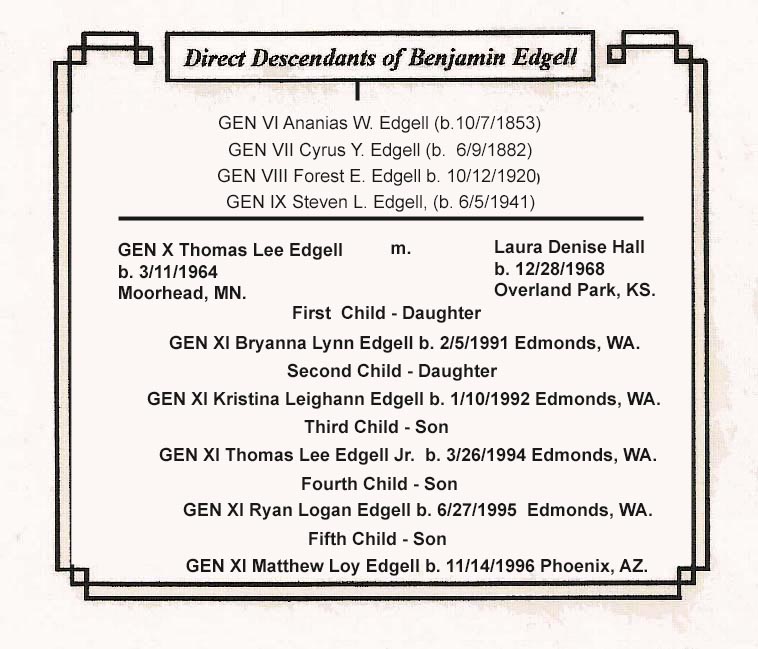
.jpg)

GEN XI Bryana Lynn Edgell b. 2/5/1991 Edmonds, Washington
GEN XI Kristina Leighann Edgell b. 11/10/1992 Edmonds, Washington
GEN XI Thomas Lee Edgell Jr. b. 3/26/1994 Edmonds, Washington
GEN XI Ryan Logan Edgell b. 6/27/1995 Phoenix, Arizona
GEN XI Matthew Loy Edgell b. November 14, 1996 Phoenix, Arizona
GEN IX Robert Lee Edgell b. 5/3/1943, Goodland, Kansas (3rd son of Forest and Lucille) Married Sharon Worscheck b. 1944, Minneapolis, Minnesota. One son, Robert Lloyd.
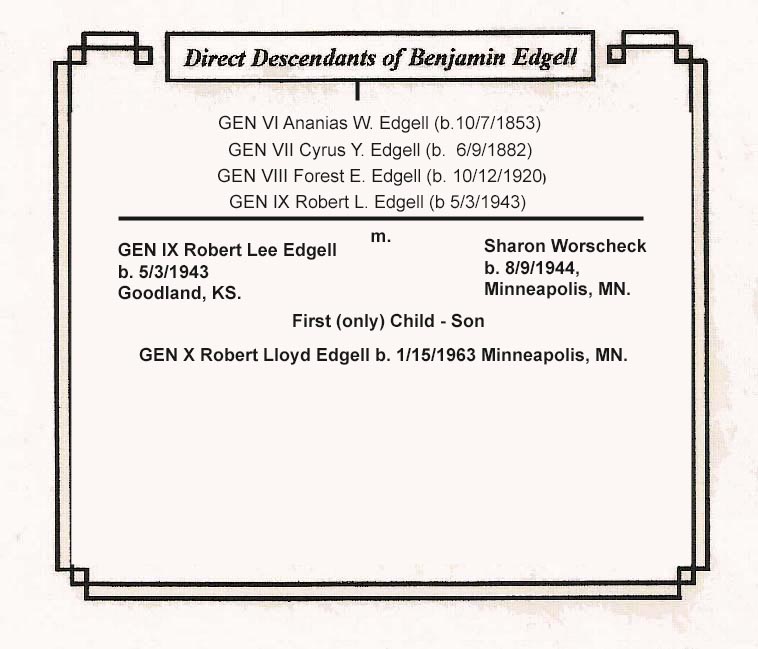

They have a son, Robby.

In 1965 Sharon and Bob divorce. After another year of college, Bob joins the Army
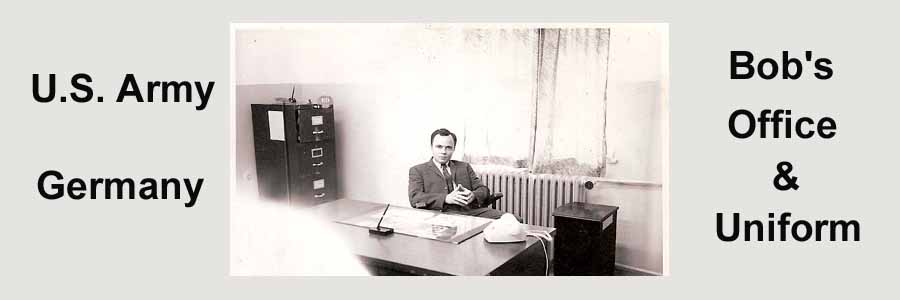
Robert Edgell's own words from his chronicles:
"When I was about three
years old, Mom and Dad were divorced and Mom married Robert (Tex)
Cochran. Life with Tex was not the normal family life. Tex was a man of
many vocations, changing his “career” path often and moving from town to
town. He was a typewriter mechanic, cobbler, owner of typewriter shops
and a liquor store. And he was also an alcoholic. We moved from Lamar to
Scott City, Kansas when I was five. During those years I stayed close to
Steve because I was kind of lost with all the kids and activity. Also I
was the next to the youngest. Lynn was living with Aunt Helen during
this period. When I was six years old, Mom and Tex were divorced. We had
moved back to Goodland and one day Tex loaded his kids, with Chuck, in
the car and disappeared. He left Mom penniless. Mom found a job for $35
a week working for Bob and Hope Bower. The Bowers owned the Bower
furniture store on Main Street across from the elementary school. We
lived in a one bedroom apartment above the Bower’s store. These were
happy times. We all became involved in the Episcopal church, Lynn was
back with us, and Mom seemed to have all her time to the three boys.
During the next three years, there were good memories of playing
monopoly and Clue, being Acolytes at the church, visiting Grandma Lelia
Baldwin at the pink house on Cherry Street, and spending the holidays
with Aunt Lois and Uncle Bob Amos.
It is important to digress here and talk about my father, Forest.
My earliest memory of Dad (Forest Earl Edgell) was in Goodland, Kansas
around 1946. I was about three years old at the time and Dad came up the
walk to Grandpa Robinson’s two story house in Goodland, Kansas where we
lived. I was running with Steve and Lynn to meet him. After that,
several years passed and I remember visiting Dad in Denver (the day was
August 8) where we spent the day at Elich Garden park, compliments of
Dad’s employer, Gates Rubber Company. When I was ten, Dad visited us in
Branson, Missouri. At age 14, Dad came to Minneapolis for Lynn’s high
school graduation. I remember this time very clearly. I had a great deal
of admiration for him, his stature and manners. Dad didn’t attend Steve
or my graduation. It was 32 years later when I saw Dad. I cannot explain
why so many years passed between our visits. I had been in Denver many
times and Dad had been in Phoenix many times. For some unexplainable
reason, neither Dad, nor I, nor Steve, would pick up the phone and call.
After 32 years, Dad and I met in Blair Nebraska at Lynn’s house. We both
arrived for Suzie Edgell’s graduation from high school. Since then, we
have stayed in touch. We had a family reunion at Dad’s house in Denver
in 1988 with all the boys. This was our first chance to meet the son
that Dad raised, John Rankin. John is Lola’s son and he lives with his
wife Bunny and her two sons, Matthew and Justin.
Mom said many times that Grandma Edgell was a wonderful person, however,
I can’t remember her. Nor do I remember grandfather Yale. I did not meet
Aunt Helen or Uncle Harold until I was 50 years old. I do not know if it
was my first step to make or that of the older generation. I feel it was
my loss not to have known the Edgell side of my family and not to have
had their influence growing up. I miss their stories and histories that
they could have shared.
During my second grade at the Goodland Elementary School we had an
exchange student, Gunta Bekis, from Holland. A good part of the year was
devoted to a musical play about Dutch boys and girls. My favorite
teachers at the Goodland elementary school were sisters, Mary and Eileen
Dean. Mary paid special attention to me when I was in her fourth grade
class. A spelling bee was scheduled for the fourth through sixth grades
and Mary helped me prepare for it every day after school. My first love,
only she didn’t know it. I won the spelling bee.
The big goal we had in Goodland was to buy bicycles. Steve had a job
at the barber shop on Main street, shining shoes and cleaning up. Every
day he would come home and we would divide up the money. My share was
25% for doing his chores around the house. In no time we had bikes we
bought with the money. With our new freedom, Goodland became a town to
explore (as much as you can in a farm town with a population of 5,000).
Lynn was the big brother (also known as Tarzan) and brought humor to the
family by reading joke books and telling stories. Steve was the more
serious type. The brothers Lynn, Steve and Bob had the usual amount of
togetherness and fighting. We came up with names to call each other.
When one person did or said something socially incorrect, we would point
and say, “stinky pooh on you”. Lynn and Steve would get my goat by
pointing to my ears and say I had gravy behind them. Pretty mild stuff.
These were the days of the Tarzan (Johnny Weismueller) movies and Lynn
liked to play the big brother/Tarzan role (when he wasn't reading joke
books and telling corny jokes). You have to admire these two brothers.
There is a kernel of character in both that has not wavered through the
many changes and glitches in their early years.
And then Tex returned. Tex convinced Mom he had stopped drinking and
before we knew it, Tex had our furniture loaded into a truck marked with
“Cochran Mattress Factory”. We all drove to Great Bend, Kansas to our
new home, a two bedroom apartment attached to the mattress factory. The
transition was not smooth. Tex’s boys were starting their teen years and
behaved like standard teenage jerks. Fay Ann told us stories about how
Tex would leave Charles Stanley (Chuck) in charge when he was away and
Chuck had become a spoiled monster. We soon found out Faye was not prone
to exaggerate. We also found out that Tex had sold our bikes in Goodland
and kept the money. We moved from the mattress factory to a two story
house we called “Red’s” house. The only benefit from the Tex move was
our first TV. I believe the only time we were allowed in the living room
was Saturday mornings so we soon got hooked on “Winky Dink and You”, a
cartoon show. One night we loaded the truck (Tex said we were loading at
night so as not to disturb the neighbors) and drove to Springfield,
Missouri.
We stayed in Missouri for two years, living first in Springfield,
then Branson, then back to Springfield. The first stay in Springfield
seemed brief. I think it was during that time we got to know Tex’s dad
who lived a few blocks away. One day the old guy had enough and blew his
brains out. Branson was a small paradise. Tex bought a house on the
highway coming into town, across the street from the Dairy Queen.
Attached to the house was a liquor store and a small retail front that
Mom used as a photography studio. These were some great times. Regular
Huck Finn style. A short distance from the house was a river and an
abandoned fish hatchery. One of the good things about living with Tex
was his dislike for having too many kids around. We had all the freedom
to roam and explore. Steve, Fay and I formed a club, the “Dia-Look club”
(Kool-aid spelled backwards) and took turns being the President of the
club. The main job of the President was to get the money (pop bottle
returns was the main means) to buy kool-aid for the day. Forest visited
us in Branson and we spent a lot of time across the street at the Hotel
swimming pool. I was a little in awe of dad. He was good looking and
dignified appearing. It was like being in the presence of a Statesman
and never knowing what to say.
Springfield was a town to explore. Our wanderlust from Branson
carried over and we literally walked the town.. Mom and Tex were
fighting a lot so it was time to play the disappearing act. One of our
favorite places was the army surplus store downtown. We explored with
walkie talkies and electricity. My first fight was in Springfield. I
told a black student not to walk on the basketball floor with street
shoes. I didn’t win that one. My favorite teacher was black, female,
about 5’5” and very round. One Friday Mom and Tex had a fight and Mom
told us to check out of school, we were leaving. When I told my teacher
I was leaving she started to cry and pulled me in for a hug. This was an
unforgettable hug, with my head pulled between two very large brown
breasts. Mom and Tex made up over the weekend and Mom told us to check
back into school. I can remember being nervous about checking back in
but anxiously anticipating another hug. My fears were unfounded and my
fantasy realized. More tears and The Hug.
Back to Springfield. A short time after the last “big hug” we
checked out of the Springfield school and Tex’s circus for good. Mom
allowed Tex to continue raising Chuck with the other Cochrans while the
Edgell brothers pack our belongings into a small trailer and Marion Dean
(one of Tex’s sons) drove us to Minneapolis. This was January, 1955.
Relocation to Minneapolis.
We moved to a small duplex on 14th Avenue, one block from “Dinky
Town” and ½ block from Marshall High School. In 1957 Lynn graduated from
Marshall High School and Dad visited from Denver for the graduation
ceremony. Sometime in this period, Uncle Gary Robinson visited from
Chicago and I flew back with him to spend a week. Gary was an impressive
person. His gray mustache and expensive suites gave him an air of
importance. He had done well as did all of Lelia’s brothers. They had
gone to college and graduated from engineering school. Ira Robinson
spent a decade of his life working on a government dam. Gary was a
litigation appraiser. Large companies in Chicago would hire him on
contract to fight the property tax assessments on their real estate
holdings.
Marshall high school was friendly to the Edgell boys. Since we were
from Missouri, they called us Big MO, MO and Little MO. These names
stuck for several years. We were the hicks from Missouri. Lynn and Steve
paved the way for me, making their marks in sports and scholastics. Both
were athletic and popular. In the ninth grade my rebellious years began.
It seemed everyone was busy so I had to find my own way. My choice of
friends was not the smartest move I have made. We were a small group
from “broken” homes so we had a lot of freedom to get into trouble. In
my sophomore year I was on the wrestling team with Steve and changing
from the rebel. With absolutely no help from me the team won the city
championship, my first and last sports letter. In the spring of that
year 50 students, mainly juniors and seniors (I was a sophomore) were
caught in a field in Savage, Minnesota having a beer party. The school
suspended everyone for a year from sports. That was the end of my high
school sports. I did not get too involved in High School activities,
except for the H.S. play, “Arsenic and Old Lace”. I had a bit part, Mr.
Gibbs, who the sisters wanted to poison but was chased off by the son. A
few of us would hang out. I literally hung out my entire senior year.
Staying up late most weekdays, many time skipping school. A small group
of us (Brockman, Gleason, Eklund, Musil) would sometimes play Bridge all
night. For late night coffee we would visit the White Castle on the
corner of Central and 4th Streets. I graduated from Marshall High School
in 1961 very close to the bottom of my class.
The jobs I held in High School were not exciting. First it was $1 a
day to work with Mom in the laundry on Sundays, sorting and folding
clothes when I was twelve years old. Then came window washer/clean up at
a local restaurant, working at the Tub laundry and Clark gas station.
The Clark gas station was my first encounter with a gun pointed at me.
At midnight one night a man came in and while pointing the gun demanded
the money. I gave it to him. The police came and we called the owner,
Del Zeitler, who hung up the phone when I told him I had been robbed.
Del had been successful that night at the single bar and was busy when I
called. He yelled into the phone, “don’t rob yourself tonight and don’t
bother me”. Finally, the detective called him and told him he had to
come to the station. Mom and Steve also went through the experience of
being held up at gun point.
For a year after high school I worked for a company called Guardtone
(sales and installation of security equipment). First as an installer
then as the PR man trying to calm down the unhappy customers. At
Guardtone I met Sharon Worscheck, a high school senior from Bloomington,
Minneapolis who was working at Guardtone in telemarketing. We began
dating and got married September 12, 1962. On January 15, 1963 our son
Robert Lloyd was born. Robby was a happy baby and lots of fun.
In 1995 I visited Washington D.C. on business and had a day to tour
the monuments. I was particularly interested in the Viet Nam Memorial.
Our good friend, Dick Musil, had a brother who spent two tours in Viet
Nam and was killed in action. When you visit D.C., you first get a map
of all the monuments. I located the Viet Nam memorial on the map and
headed for the park. As I crossed the street to the park I saw several
tourists and far into the park was the Korean War Memorial. On the map,
it indicated I was less that 50 yards from the memorial, but nothing was
visible. I walked the cement path leading into the park and then noticed
the path split. To the right the path led down into a long, deep hollow.
Hidden from the street, below ground level, was the famous black granite
wall with over 50,000 names of the casualties of the Viet Nam War. I
located the brother of our good friend, “Captain Clinton John Musil Sr.”
Of the many emotions I was feeling, anger kept forcing its way to the
front. A phrase kept ringing through my mind: “A doctor need not worry,
his mistakes get buried”. As I looked at the “buried” memorial, I
couldn’t help feeling the anger at the congressmen and officials who
sent the youth of our country to fight a senseless war, while shielding
their young and their friend’s young from the draft and the horrors of
Viet Nam. They did not want to be reminded of their mistake so they
buried it. They are able to drive around the park and not have to look
at the memorial to the dead and the icon of their own mistake.
I joined the U.S. Army in June of 1966. I joined with the provision
of being trained in counter-intelligence methods. After eight weeks of
basic training at Fort Leonard Wood, Missouri, I was sent to Fort
Holabird, Maryland for six months of intelligence training. Before my
class began, I learned a new class was starting for intelligence
collection. I requested and received a transfer to the collection class.
The class consisted of all methods of meeting and recruiting people who
could gather information as well as methods of transferring information.
When the class ended, all the recruits who spoke French were sent
immediately to Viet Nam. The “dummies” who did not have a second
language were sent to Monterey, California for eight months of language
training. In Monterey I experienced California living, sunshine and
leisure. They assigned me to a German class and for eight months I
studied German and became proficient. I met a girl in Carmel and we
dated for six months, traveling throughout northern California and
Nevada (Tahoe was our favorite place) on weekends. In January of 1968, I
was assigned to intelligence collections in Germany, feeling very
fortunate at avoiding a tour in Viet Nam. When I arrived in Germany, all
my military clothing was stored and I was given money to buy German
clothing. Also, I was given three identities to use and a German
automobile. For the next 18 months I lived in an apartment with other
collection officers and we experienced a lot of low level collection
activity. We were bird dogs, interviewing Germans, Czechs and Polish
from the “East Bloc” countries who may have intelligence about military
activity. One event stands out and worth noting.
I got a call one night from the counter intelligence group in our
small town in Germany. Two West Germans in a white Mercedes had shown up
at their door and wanted to sell the Americans what they described as a
film of the latest Warsaw Pact Maneuvers in the East. The Warsaw Pact
Maneuvers always included the latest in military hardware and strategies
and they were asking $100,000. We went to the CI office where they had
the lounge with hidden microphones and a two way mirror. We watched
through the mirror for a while as one of the CI officers interviewed the
two “thugs”. Their main business was smuggling expensive goods between
West Germany and Czechoslovakia and occasionally smuggling a person out
of Czechoslovakia in a hidden compartment in the Mercedes between the
back seat and the trunk. We negotiated until 3 a.m. until they finally
agreed that we needed the film authenticated at headquarters in
Heidelberg, Germany. We timed the trip and the showing of the film so
that we could be back in Wuerzburg early morning and we would meet them
at a café on the Autobahn. When we arrived in Heidelberg at 4:30 a.m. we
were greeted by over thirty weapons experts in a screening room and
their commander. The film was only 30 minutes long and at the end, we
were told that it was in fact three years old and Heidelberg already had
a copy they took off the East German television signals. Since the film
was a better copy, we were told we could pay them $1,500. It was an
unsettling feeling to have to return to the “thugs” and offer them
$1,500 when they were expecting $100,000. It was time to go on the
offensive. When we got to the Café, the thugs were waiting and we told
them how they had wasted our time and the real truth of the films
origin. After a few minutes of arguing and whispered shouts, they calmed
down and said they wanted to show us something in the Mercedes. We went
to the parking lot and they showed us a trunk full of fur coats they
were smuggling into Czechoslovakia that day. Most of my activity in
Germany was spent verifying the status of military bases in the East
(was a motor pool on our maps still a motor pool, an infantry base still
an infantry base) and any signs of movement. Twice a month I would meet
an East German agent who traveled between East Germany and West Germany.
We would meet in a safe house and I would pay him and assign a new area.

Living in Europe for 18 months was a remarkable experience. I traveled throughout Germany on “business” and during vacation time I traveled to Italy, France, England and the Netherlands. I was the genuine tourist. Visiting all the churches, museums and any place that had historical significance and art.
In June of 1966 I received my honorable discharge and returned to Minneapolis.
In the fall I resumed my education and received a Bachelor of Arts
degree. I continued at the U of M after my graduation, attending
post graduate classes in business and trying to gain admittance into
the Law school. Our main activities at that time were fishing, water
skiing and tennis. Also, I became involved with the Republican
party. First as a precinct captain then as Ward Chairman.
Minneapolis is divided into thirteen political wards and we were
responsible for electing a city councilman, two state legislatures
and a state senator. My Ward covered the University of Minnesota and
a portion on the west side of the Mississippi river. We were very
successful at winning all the elections because of the divisions in
the democratic party. In 1968 Richard Nixon won the Presidential
election on the platform of “an honorable peace in Viet Nam”. As
Ward chairman, of course, I went through the campaign process, doing
Ward duties. In 1972 Nixon campaigned and won on a platform to get
us out of Viet Nam. During this time I met Brian and Carolyn Golberg
and we have been friends for over 23 years. When I moved to Phoenix
I kept the friends and lost any interest in party politics.
During the summer Steve and I built a boat: 16 foot runabout.
In 1973 I moved to Phoenix, Arizona. When I traveled
from Minneapolis to Phoenix in 1973, I stopped in Denver and picked
up Mom. She had packed her things and was ready to move. I was
driving a 1966 Mustang and pulling the boat Steve and I had built.
We put a few of Mom’s things in the boat and drove to Phoenix. In
Phoenix, mom lived with Sue Riordan, at this point divorced from
Pat, and helped Sue with her son, Shawn Riordan. Mom was a good
influence on Shawn, teaching him art, reading and values. Mom was a
good story teller and prolific reader. From 1979 to 1986 Mom lived
with me and Sue.
In 1972 Steve and I became players and followers of a tavern game
called “Foosball”, or table soccer. We were both at the U of M and
hung out at the “Big Ten Bar” on Washington Avenue. We began to jot
down notes on the offense and defense of playing the game and the
strategy of play. When we arrived in Phoenix, we had a full
manuscript of a book we called, “Table Soccer Rules and Strategy”.
Fortunately, one of the manufacturers of game tables (Mirco Games)
was located in Phoenix and we were able to convince a local
publisher to publish our book. The book sold about 20,000 copies and
after a short period, I went to work at Mirco Games as Marketing
Manager. There I worked with Richard Raymond, Bob Kaiser and John
Walsh. Mirco gave me experience in Sales and Marketing which was to
be my life career. My largest account was Montgomery Ward which
bought soccer tables by the truckload.
In 1978 Sue Riordan and I became roommates . In 1979 I went to work
for a computer firm, Graphtek, owned by Dr. Marvin Ling. Graphtek
applied computer technology as a contract business and we were
involved in security systems, talking poker video games for the
gambling market, and vectorization programs for the blueprint
market. I was the General Manager and hired Sue Riordan (we were
living together at the time) as the purchasing agent. Sue and I rode
to work everyday and talked about all the events and people at
Graphtek. Since she worked at Graphtek, she saw things differently
and we never ran out of conversation topics. Vectorization was a
leading technology and after putting all our eggs into research,
which the company could not sustain, we had to declare bankruptcy. I
was a good student at Graphtek, learning computer hardware and
software on an application level.
In 1985 Sue Riordan and I decided to get married and wanted a
gathering of family and friends. We had been living together in a
rented house with Mom, Shawn and one of Sue’s nieces. We rented a
wing of a resort (Poco Diablo) in Sedona, Arizona and family and
friends joined us for the wedding (January 12, 1985). We had a
justice of the peace from Flagstaff perform the ceremony and he
offered a Navajo Indian wedding prayer at the end of the ceremony.
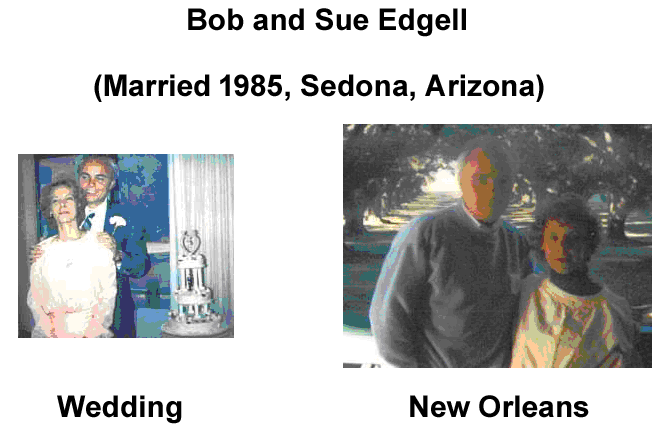
In 1985 Dr. Ling and Mike Cassidy (both of Graphtek) started a
company called GTX and hired Richard N. Stover as the Vice President
of Marketing. Dick hired me as Account Manager. I need to get a
little technoidal here for those later generations who may be
interested in this generations archaic technology. GTX made parallel
processing engines and developed software to convert dot pixel data
to line vector data. It was an emerging technology in the area of
document management and the “paperless factory”. In order to be
paperless, a company had to get all the paper (blueprints and
documents) into electronic form. Scanners were available to scan the
blueprints and make an electronic file (all simple dots). The GTX
product automatically converted the dots to vector lines for easier
storage and viewing/revising in computers. Richard Stover would be one person
from whom I have learned a great deal. Dick had a unique outlook on
markets and a mature method of strategic planning. Today, he
publishes his own trade journal on Document Management. After six
months at GTX and after setting up a French distributor, I took over
international marketing and sales.
In 1986 a German distributor visited GTX and wanted to negotiate a
distribution agreement. I had not used my German language since 1969
so I was embarrassed to try speaking German with them. However,
during the negotiation they would speak German among themselves. I
could understand what they were saying but it didn’t provide any
advantage. A few months later, after practicing my German, I went to
Albstadt, Germany and met with the same distributor. We began
speaking German and it seemed quite natural until one of them
remembered the negotiating in Phoenix. We all had a good laugh. It
was here that I met Berndt Bodmer and his wife Claudia. A few years
later they visited me and Sue in Phoenix. Here Berndt is having
breakfast on the patio and is joined by Mike our dog. They
later divorced and Claudia became Claudia Schmidt. Through Facebook
and other media we keep in touch regularly. Berndt became a very successful
businessman in the solar energy business and used part of his wealth to
collect Chevrolet Corvettes.
For the next two years, I divided my time between Phoenix and
Europe and Far East. The European trips became easy. Instead of planning
(and the difficulties of a long range itinerary), I would simply buy
a round trip air fare between Phoenix and Paris for a five week
stay. I would arrive in Paris and spend two days contacting the
distributors and making appointments. The Paris distributor was the
last on the list, being very upset that I had not given them a
months notice that I was coming to Paris. From Paris I would travel
by train to Lausanne, Switzerland, meet with Francois Vollner the
distributor and then on to Germany by train. From Germany or
Switzerland I would get a round trip air ticket to London and visit
our London office. Then back to Paris and on to Madrid and Italy.
The happiest trip to Europe was the journey when Sue accompanied
me. We went to Paris where she was very turned off by the “no
English” attitude of the French. I never had much trouble in France
with the people and the taxi drivers. My second language is German
and when I was on the economy in France I would simply speak German.
The Germans are the most traveled in Europe and the most respected
(or feared) because they don’t allow the locals to take advantage of
them. In a taxi, for instance, I would hand the driver a note with
the address where I wanted to go, speak a little German, and take
out a map of Paris. I never had the feeling as if we were going in
circles. From Paris, Sue and I went to London where she was given a
royal treatment by the personnel in the GTX office. I had to go on
to the Hague, Netherlands and Sue traveled by limo to Northern
England with a “somewhat” historian for a driver. She then took a
ship from northern England to Rotterdam and joined me in The Hague
where we stayed at the Kuhrhaus, a palace of Queen Beatrice that had
been converted to a hotel. Europe is an easy country for traveling.
I have seen many of the sights in Europe and the far east, with many
sights remaining to be seen.
One of our most memorable events was building a log cabin on
property that me, Sue and Steve owned up north in Pinetop, Arizona.
We bought the land in early 1990s and in 1999 we decided to build
our dream getaway. We found a builder, "One Tall Builder" (so named
because he was 6'6" tall) and listed all the steps in the building
process, from the footing to the finished product. We, the family
(Steve, Sue, Shawn and myself), chose those steps that we would
accomplish and they included: staining inside and out, caulking,
decorative rock along the outside stem wall and of course
furnishings. Here is a gallery of our work.



The cabin was instantly popular with friends and family. Here are some photos from a party with Sue's family: Chuck and Jeanne Walsh, Jim and Carol Walsh, John and Jill Walsh and Bob and Sue.


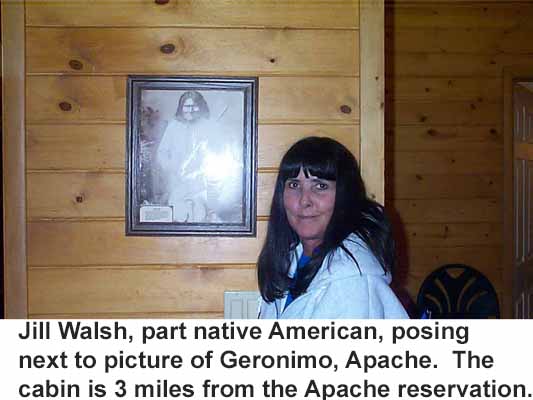
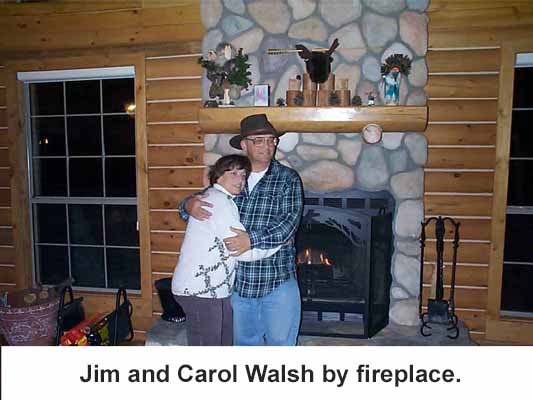
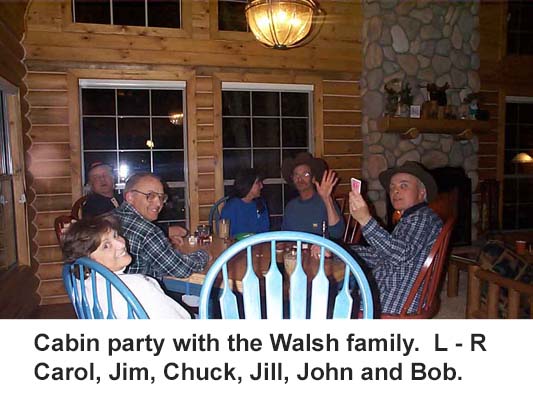
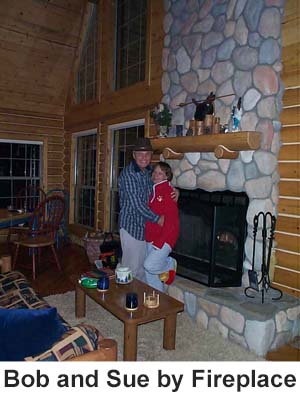
There is a sad ending to the cabin. First a backstory. Originally Bob, Sue and Steve bought three adjacent vacant lots
in Pinetop, Arizona. A small wooded town in northern Arizona, elevation 7,000 feet with mild summers and snowy winters.
Steve then started a romance with Carol Eklund and they moved in together in Steve's home. Carol eventually tried to coax
Steve into letting her buy into his lot (he owned one lot and Bob and Sue owned two lots) and he adamantly refused. Bob and Sue
relented and sold her 1/3 of their two lots. Years later the four of them decided to build the cabin and it would be situated
on part of Steve's lot and part of the adjacent lot. This brought up the issue of how to deed the property. Steve would only
consider one option: Joint Tenents with Right of Surviorship. The meaning of which is when there
are two or more people who own an equal interest in a property, when one person dies their interest passes automatically to the surviving
joint tenant(s). Steve insisted on this in case he was the last owner, he didn't want Bob, Sue or Carol's heirs outvoting him on the
disposition of the cabin and property. The sole survivor of the four would own the cabin 100%. Fast forward to 2005 when Steve has a
heart attack and dies. Up to that point, the four were content with their lives and each other. Bob and Steve both had successful
careers, Carol and her sister owned and operated a Montessori School and Sue worked at the school. In October of 2006 Carol's wealthy father
passed away and left each of his four children approximately $4 million dollars. Carol then began to exhibit strange behavior. She
became harsh to her sister Kay and also to Sue...........to the point that Sue quit the school.
Carol then started a campaign to force Bob and Sue from the cabin. This campaign began when she stopped paying the natural gas company (her
responsibility) in a winter month. The cabin caretaker who lives in Pinetop called Bob and told him there was no heat in the cabin and
there was a danger the pipes would freeze: causing costly damage. Bob and Sue left immediately for Pinetop, stopping at an Ace Hardware
along the way to purchase electric space heaters and fire logs. They were able to keep the temperature in the cabin above 40 degrees and
prevented the pipes from freezing and pleaded with the natural gas company to turn on the gas after they made the payment.
The next incident was the destruction of the cabin interior. Carol found some 'thugs' who she sent to the cabin with a long, handwritten
note telling them to cause at least $50,000 in damage. While they were there, the cabin caretaker called Bob and told him there were
people in the cabin so Bob told her to call the sheriff. They stayed on the phone until 5 police cars arrived and the police surrounded
the cabin with guns drawn. This is a typical police reaction in Pinetop because as in all 'vacation' villages where the owners don't
occupy their residence full time, burglarys are very common. After some time, the 'thugs' convinced the police they were authorized to
be there and they got Carol on the phone to varify their claim. Bob and Sue then drove to Pinetop with the intent of changing the locks
and checking out the cabin. What they found was disturbing. There was indeed $50,000 damage and to top it off, the note Carol wrote
was laying on the floor along with other papers, the expensive Kachina dolls that adorned the mantelpiece and other valuables.
Bob and Sue confronted Carol who refused to discuss anything regarding the cabin. Bob and Sue then started a court action called 'Partition
to Divide.' In this case, a judge orders the two parties to come to an agreement as to ownership or dividing the property. If the owners
can't come to an agreement, the judge can order the property to be sold and the proceeds divided among the owners. The court hearing was
held in Holbrook, Arizona and before the hearing, Carol offered to buy Bob and Sue's interest in the Cabin. There was a dispute as to the
amount because Carol insisted that she owned Steve's share so therefor she was half owner. Bob pointed out that with the deed as Joint Tenants
with Right of Survivorship, Steve's shares no longer existed and she in fact owned 1/3 while Bob and Sue owned 2/3. In the end, the parties
agreed on an amount and Carol purchased Bob and Sue's share of the cabin. At that hearing was the last time Bob and Sue visited the cabin
nor had any meetings or dealings with Carol.
Before leaving this section on the cabin, it is important for my history to introduce family that Sue brought to me: her mother Thelma; her brothers Jim, Les,John, Chuck and Bobby and her sister Linda and all their spouses.
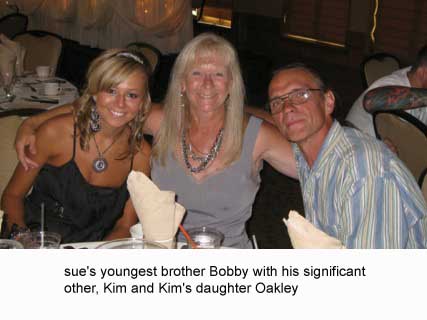
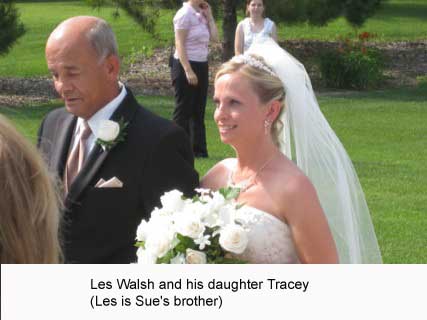
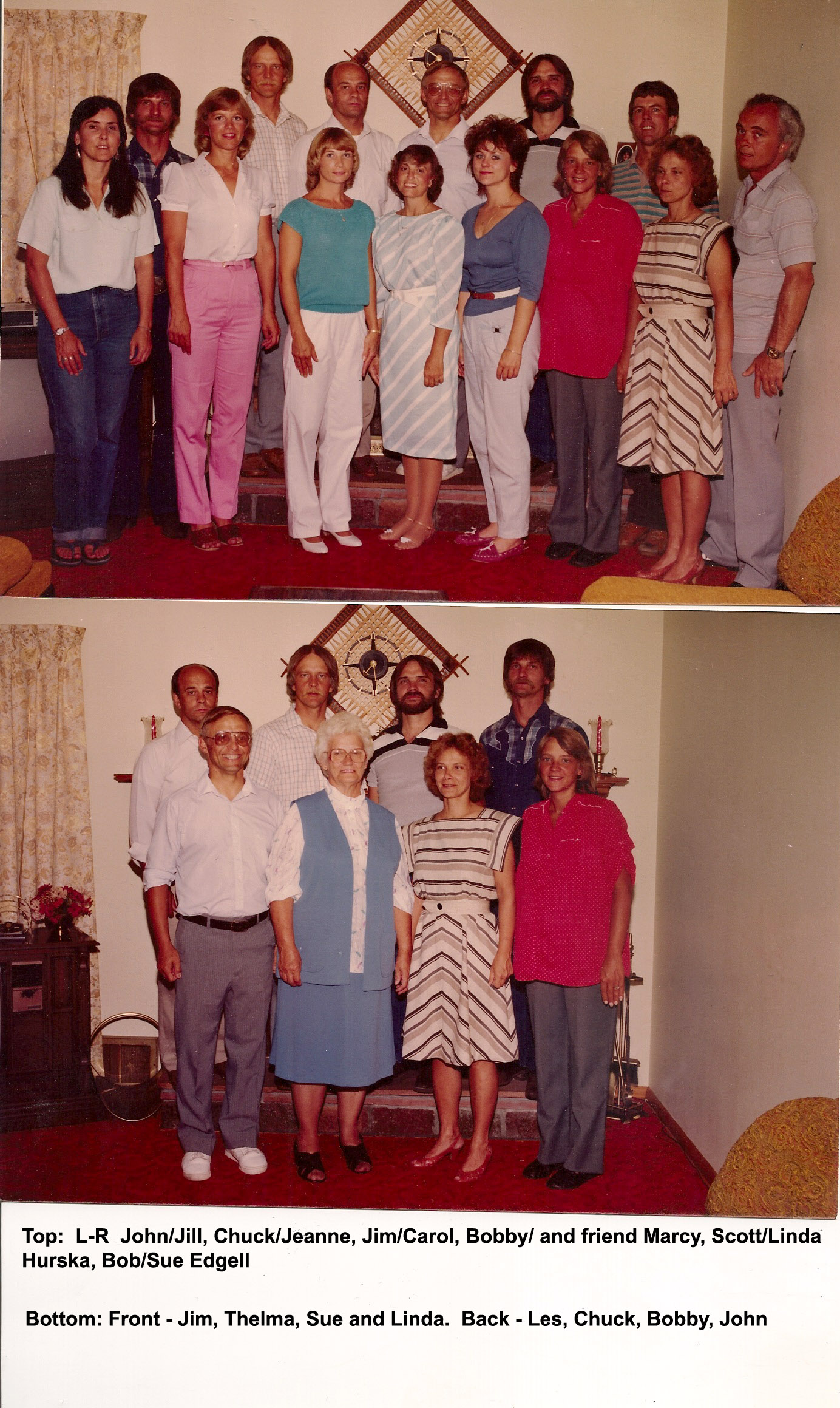
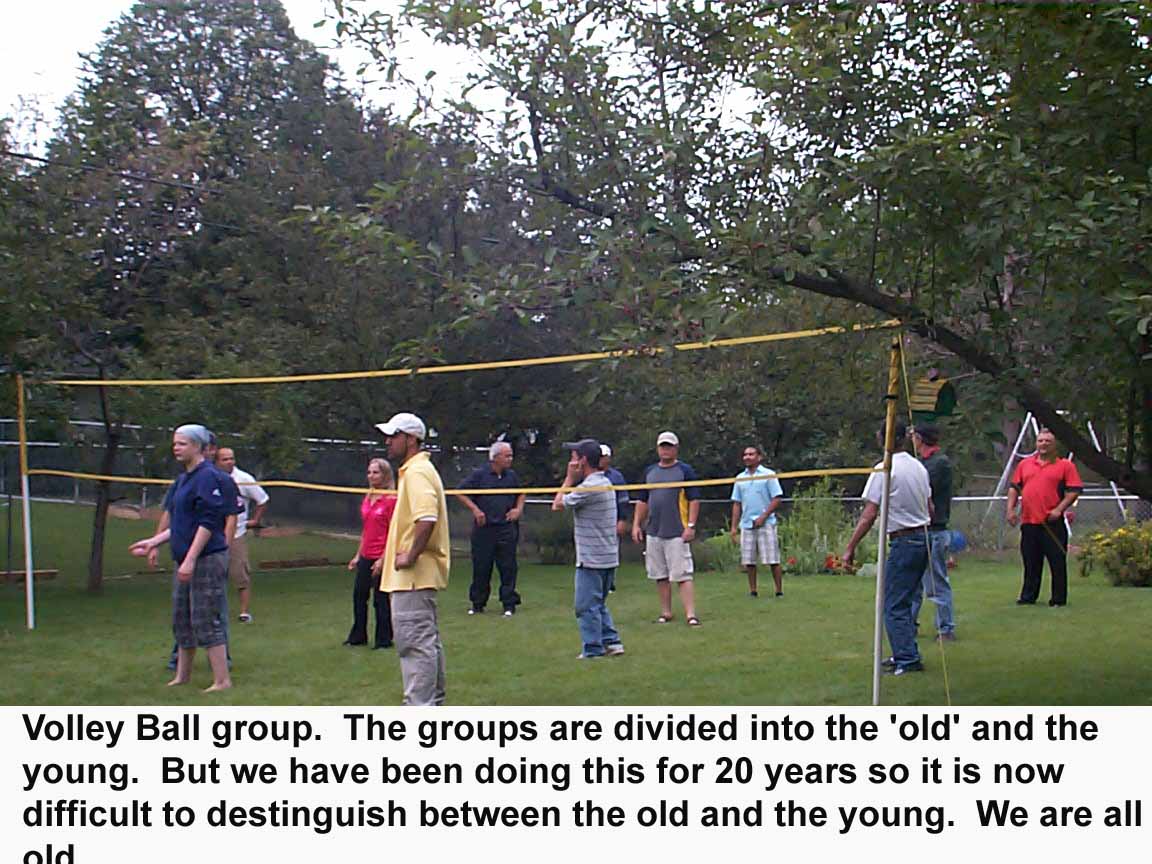


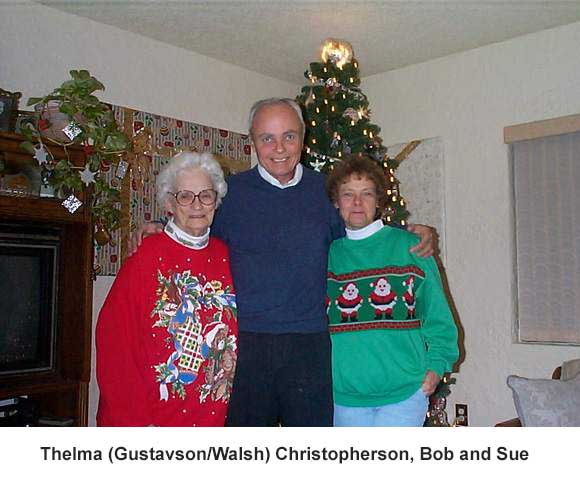
My mother Lucille, could be described in many ways as the conventional mom.
Holidays and events were special and she always went to the effort
to create the atmosphere and celebrate. Christmas was full of
decorations, cards to friends and relatives, and the food. She would
put a lot of effort into the Xmas meal. Her most notable were her
“snowballs” (made of layers of vanilla wafer cookies, grapes,
crushed nuts, coconut, whipped cream). When Mom was not with Tex,
she put her attention into her family. Through our high school and
college years, Mom would support us in our decisions (although she
did give me a hard time about some of the friends I chose). She
would co-sign for automobiles. One story may give you a glimpse of
Mom’s values and discipline. When I turned 16 and earned my driver’s
license, I had $125 saved to buy a car. I convinced Mom that I could
buy a car, park it in the back yard (fix it up) and not drive it
until I had saved money for the car insurance. I bought my first
car, a 1949 Oldsmobile 98 and drove it home from the car lot. I
remembered that the salesman had promised a spare tire which was not
in the trunk. Since Mom was at work, I drove back to the car lot and
picked up the tire. The next day after school I called Mom in a
panic because my car was not in the back yard. She told me that she
had “stolen” it and I would get it back when the insurance was paid
and in force. About three months later I went to Uncle Bob’s house
and picked up my “insured” car. Later, when I was in college, Mom
was working 60 hours a week at Harvard Market on the U of M campus.
She always had many friends and the students that came into the
market liked her and some depended on her. She was like a small loan
company. The regular students could depend on her. She never wrote
anything down and never asked for the loan to be repaid. Several
students, after graduating and moving away, would stay in touch with
Mom on holidays. When Mom came to Phoenix and stopped working, she
was again generous with her time.
In late 1985 my mother, Lucille, was diagnosed with advanced cancer.
She wrote a letter to my uncle, Bob Amos, on December 12, 1985 and
Bob gave me the letter in 1996. Here are her words of that period in
her life.
“Dear Bob and all,”
“Thanks so much for your prayers and concern. I would have written sooner but just didn’t have the umph. But I am really getting along well and getting stronger every day. Chuck came and spent 2 weeks with me. He was wonderful. He got my meals and pampered me beyond belief.. Lynn and his family are coming for Christmas - driving down - leaving Blair the 20th so they should be here on Sunday night or Monday morning - weather permitting.” “You’ll never believe how kind everyone has been. Sue does so much for me. She has to help me mornings with my stoma and it takes about 1 ½ hours (every other day now). Sue’s sister-in-law, Carol, has done so much. Helped me bathe - cut my hair - gone after medicine, etc. etc. etc. My friend Eileen had company arrive from Mpls the day I was operated on and the lady stayed for three weeks.
Eileen was beside herself, she wanted to be with me so badly. Now she
will make up for it because beginning today she has to take me to the
hospital 25 days for my radiation treatment. I was operated on exactly a
month ago (November 13th) and am doing amazingly well considering the
extent of my operation. I got so discouraged in the hospital because I
was so weak and I kept watching all those hysterectomy patients get up
and walk around and leave in a few days and I was there 12 or 13 days.
So the last day I told one of my many doctors that I was discouraged and
he said “remember girl, these women have had ordinary operations, you
had a biggy”. “I had a tiring day today. Was at the hospital for 3 hrs.
and most of that time flat on my back and I couldn’t move or even flinch
while they measured me exactly and painted X’s and check marks all over
my stomach, which I can’t wash off for 5 weeks. The zap of radiation
only takes about 15 min. so the rest of my trips will be short. Eileen
brought me home and we had a nice lunch at 3:00 pm. I cooked some beef
all day and put noodles and mashed potatoes with it after we got home. I
was surprised I felt like it. I can’t sleep much at a time. I take pills
every 3 hours, day and night. Usually the pain starts in about 2 ½ hours
and then it takes ½ to an hour for it to take effect. The pain is caused
by the pressure on nerves by the tumor, which is about the size of a
grapefruit. The radiation kills and shrinks the tumor and the Docs say
that most of the pain will go away after I’ve had a few zaps, so then I
should be able to stop most of the pain pills. I’ll be so glad. I’ve
never even been an aspirin taker, let alone dope.”
“I forgot to say that Robby and his darling girl friend Gwen, came for 4
days over Thanksgiving. Robby is really great. I wish they would move
down.”
“Bob has been working like a fiend trying to get my apartment finished.
Steve comes and helps him when he can. They are making me a two room and
bath apartment out of a workshop on the west end of the house. Then they
plan to take the bedroom I now occupy and make it into a plush bath and
dressing room for their bedroom…should really be nice when they get all
done.” “Well I better close - I hope you can read this mess. My hands
still aren’t too steady. When I first got home, I couldn’t even work a
cross word puzzle - write letters.”
“Everyone keeps wondering about how I feel about all this: Am I angry?
Am I afraid? etc. ect. Who or what would I be angry at? And I certainly
haven’t been afraid. I have been so calm it is amazing. You know I have
never been sick before in my life - so one never knows how you would
react to this situation but I am just taking it one day at a time and
doing what I can to improve, minding my Docs orders and all that stuff.
And in lots of ways I feel very lucky. I feel I stumbled on the best
team of doctors available and that they are doing everything in their
power to help me…I call them my TASK FORCE. And everyone, my friends,
relatives and nurses have been so great.”
“I hope you guys can come down sometime. I want to meet you, Dorothy.
Was so sorry you didn’t come last spring with the gang. And Bob, you are
my only and the best brother a gal could ever ask for.” “I hope you have
a wonderful Christmas. We are looking forward to it here, especially now
that Lynn’s family is coming. We are going to wait until the Monday
before Christmas to put up the tree so Lynn’s kids can help decorate
it.”
End of the letter.
A big event happened to me in 1996 and I wrote the following as a
way of telling my story of the event.
From a tickle to attack By Bob Edgell
October 20, 1996, Sunday. It was the day of the big one. With hours
of looking at ceiling tile and trying to reconstruct what happened,
along with answering all the questions from the medical people, I see it
is really quite simple.
It all started October 3rd when I checked into a new primary care
doctor, with a reason, a tickle in my throat. He did the usual quick
once over for a new patience and then I had a chance to mention the
tickle in my throat. I further explained that it felt like a time I had
strep throat. He gave me a little affirmative nod and a prescription for
Amoxicillin, a penicillin. Nine days later I am in Denver on a business
trip and had a reaction, histemic type. Large itchy blotches all over
the body. After three hours in the emergency room, I go back to the
hotel and continue my trip. The Doctors in Denver put me on Medrol
Dosepak (4mg) a type of adrenocortical steroid to counteract the
reaction to the Amoxicillin.
Saturday, October 19, I took the last of
the steroid pills and feeling pretty good. Sunday was a big day, a
championship soccer game to herald in the end of the season. We were
fighting for first place. Early Sunday morning my brother Chuck brought
over doughnuts to socialize and say goodbye to our Uncle who was on his
way to Mexico for Kelation treatment. Let me interrupt the flow here for
a moment to discuss Uncle Bob’s Kelation treatments. Uncle has had two
triple bypass heart operations (uncle is not a blood uncle, married my
mother’s sister). Here is what Uncle says about kelation. Each year
thousands of people go to a little clinic just south of Yuma, Arizona
and get kelation treatments. A treatment consists of sitting for about
three hours letting a clear substance drip into your bloodstream. The
substance is supposed to clean the blood and the veins and wash the
“floaters” through the kidneys. The stories of success range from an old
man with a near gangrene leg (which after two weeks the leg was pink and
full of circulation) to the many patients with heart problems who became
whole again.
So, on this Sunday morning, we were having doughnuts and
wishing Uncle Bob a get well trip to the kelation fountain. Sue and I
dropped Uncle off at the bus depot and went straight to the indoor
soccer arena. One comment we exchanged was whether we would see Uncle
again because he had had a heart attack a week earlier and had a lot of
numbness in his leg. The game started at 1pm and the first half was as
expected. We were in the lead. For the second half, I switched to
defense. About 15 minutes into the second half I was feeling great on my
shift. Running full out up and down the field. I felt great. I felt so
good that instead of my usual 3 minute shift, I stretched it to 6
minutes. Finally I subbed out. Entering the players box I felt a strong
sensation to pass out. I sat down briefly, then walked to the lounge
area to find a place to lay down. At that point my arms, mainly the
triceps and wrists were aching with a pain I have never felt, a deep,
searing pain. I tried to breath deep with no success. I kept trying to
feel a pain in my chest but could not make out a pain or a burn. After a
few minutes, I asked a nearby player to find my brother and call 911.
Within five minutes the boys in blue where there, starting IV drips and
hooking up EKG leads and asking lots of questions. Then the trip to Good
Sam. Did you know you can barely hear the siren when you are inside the
ambulance?
At Good Sam things went real fast. Wheeled into a small 10 X 12 room
with all the instruments, someone yelling to have a crash cart nearby,
someone answering it was near. Five people on each side of the bed,
sticking you with something, taking a pulse, one with a clipboard asking
questions, and me, wondering when in the hell were they going to stop
the pain in my arms. It was feeling unbearable. My chest felt OK, I was
less nauseous. Then a distinguished looking young man with a stethoscope
peered over in my face and slowly said: “Mr. Edgell, you are having a
heart attack”. It wasn’t a question, more of a statement, but I had a
strong urge to answer. I was formulating my answer in my mind: “Doctor,
I just had a heart attack at the soccer arena so this must be an error”,
when the Doctor explained that they wanted to try a new drug to quickly
dissolve the clot in the right artery. I said yes and the lady with the
clipboard passed it to me to sign. Two of the people at the bedside said
I was lucky because the chief cardiologist happened to be in the
hospital and would be monitoring the activity.
He quickly earned his respect when everyone looking at the monitor
started to buzz and discuss new fluids or doses. The guru looked at me
and said cough. I coughed. The anomaly on the monitor disappeared and
then you could hear the heavy sigh of the masses that follows a great
revelation. The guru then begins to pontificate on the anomaly and the
reason the cough provides the fix. Within an hour I was in the ICU unit,
private room, and hooked to every gadget available. The fluids going
into the system were morphine, Teclid (blood clotting blocker), Heprin a
blood thinner, and Cardizan to help the heart and prevent further
problems. Sunday night they explained the next days events and I had a
good nights sleep. Monday morning I awoke with the most painful feeling
in my right foot. The pain was the type that brings on a strong nauseous
feeling and no way to reduce it. The nurse was liberal with the morphine
but it almost seemed to do no good. At 10 am I was taken to the catheter
room where it takes three nurses to shave your pubic area (and get their
looks in. Don’t laugh, I caught them sneaking glances). The Doctor began
by putting two pencil sized tubes in your groin. One is inserted into an
artery. Then they send up the wires and you get to watch on the monitor
as they slide up the artery. When the little wire reaches a main artery
in the heart, they let burst a little fluid and watch it disperse
through the veins in the wall of the heart. This is one method of
finding clogged arteries. You get to watch the entire procedure on the
monitor as they go to the different arteries: right coronary, left
coronary, posterior descending, left anterior descending. My problem
turned out to be the Right Coronary artery where they found some
narrowing.
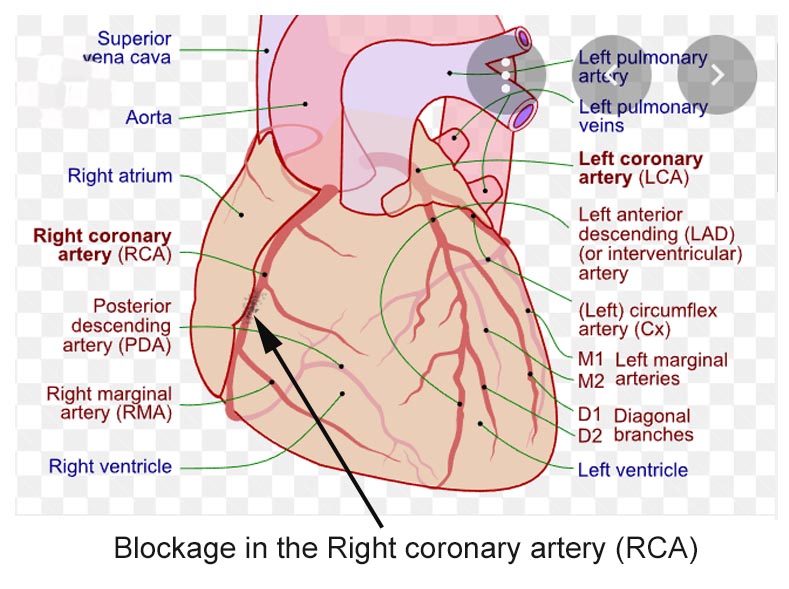
During the catheter experience, the doctor talked to me about
how I was feeling and I kept telling him that my right ankle was on
fire, unbearable fire. He ignored my pleas. He was a heart mucky-muck
and ankles were beneath his specialty.
All day Monday, all night and all day Tuesday and Tuesday night, the
ankle would not allow me to sleep. Every doctor who came into the room
would get an earful. I believe I also threatened to have another heart
attack if I could not get any sleep for three days and nights and the
pain would certainly trigger another.
Wednesday I got the visit from the “case manager” who was going to go
through all the literature on heart and get me started on rehab. We
discussed the book for an hour and then she smiles and says, “let’s take
you for a little walk so your system has a little exercise”. Well that
was all I needed to hear. Being a trooper I grabbed my IV stand with
four rolling wheels and swung my feet over the bed. As I stood the
grimace must have been more than a little noticeable. Picture this. Left
leg straight and upright. Right leg at a 45% angle to the floor because
unable to place the heel of foot on the floor. We begin our little walk.
She has this caregiver plastic smile and I have this “cut my foot off
and put me out of my misery” grimace. The experience was not without
reward. I let her know that unless someone got the point across to the
medical staff that there was really an ankle pain, I would need to
resort to coyote medicine and chew the damned thing off.
Finally on Wednesday, the orthopedic doctor paid a visit. The x-rays of
the right ankle showed two hairline fractures; not one but two. For the
second time in four days I heard the sigh of the masses after a great
revelation. “No wonder he was complaining so much”. In addition to the
ankle pain, there was the pain of the dressing for the catheter. After
punching two big holes into your groin, they need to keep a very heavy
pressure bandage on the area (especially since your blood is mainly
blood thinner at this point) to help it heal. As would happen, the
thinner won out and blood seeped throughout the groin area, swelling and
turning everything blue/black, everything. Thereafter, every few minutes
it was necessary to move the body to either change the position of the
ankle or the groin area. No sleep Wednesday or Thursday night. Friday is
the next big day in recovery.
Friday morning they planned another catheter. This is the treatment
phase. Another two pencil holes. This is the part where they insert a
balloon into the narrow part of the artery and inflate it to open the
artery to it’s normal size. In my case, they decided to go with a metal
stent. The stent is a stainless steel tube that looks like a spring. The
collapsed stent is placed over the deflated balloon. The deflated
balloon is inserted into the narrowed artery and when in place, the
balloon is inflated, the metal stent expands and the artery is opened.
The balloon is inflated several times because it is actually changing
the shape of the stainless steel stent. Once the stent is in place, the
balloon is deflated and removed. I had four of these stents inserted in
different narrowed areas of the same artery. Then the tubes are removed
and the patient is ready to spend one more day before going home. The
medication after the procedure which may lasts for several weeks is
Cardizem, a calcium channel blocker to relax the blood vessels and
increase the supply of blood and oxygen to the heart, Ticlid to keep the
blood thin to prevent clotting around the new stents and one aspirin per
day.
So, looking at the ceiling tiles for several days and wondering, “why
did this happen to me?”, a third great revelation occurred, but without
the masses and the sighs. Some types of Steroids can be very powerful
painkillers. The tickle in my throat in early October, which prompted
the penicillin, which in turn started the hives-like reaction and the
emergency room visit in Denver, led to the use of the Medrol Dosepak
steroid, which in turn gave me superhuman ability in the championship
soccer game and the ability to play with a multiple fractured ankle, and
led me to extend my three minute shift to six minutes. From a tickle to
attack.
The End
At the time of this writing, I am dabbling in family history to find
the ancestors to Benjamin Edgell. The summer of 1996 was especially
enjoyable making new contacts with Bud, Helen, Lee (Nellie Jane) and
catching up on their lives. I hope to finish the first edition of the
Edgell Chronicles in 1998 and have everyone’s autobio included. After
the first edition, this generation can pass along the compiling duties
to the next generation for future updating.
Postscript written in 2022.
I certainly never expected to live this long. I am almost 79 1/2 and
still active. I have to thank modern medicine for my longevity. Because
of my genes or food habits, I have very high cholestoral so my plumbing
tends to clog with placque and the procedure described for the heart
attack has been repeated several times: with many stents placed in the
heart and femoral arteries. It is likely due to genetics since
Steve had a heart attack on the same soccer arena as I did and later
died and Lynn died from a heart attack.
I have
been very active in tennis and golf over the years with only a few signs
of slowing down. During the period between the first and second heart
attacks I have won tennis championships, coached, managed teams, gotten
two hole-in-ones in golf, built a log cabin with Steve, Sue and Shawn,
traveled every year to Minnesota to see Rob, Corinna, Madison, Carter and the
Walsh family.
I will have more to say at a later date but will end with this word
of thanks for my wonderful wife, two sons and the many relatives and
friends who have made this life enjoyable. Everyone brags about their
children and I feel compelled to share my feelings about Rob and Shawn:
they are the most caring, giving of themselves and generous as anyone
could hope for.
GEN X Robert Lloyd Edgell (Phyle) (son of Robert and Sharon) b.
1/15/63 Married 11/2/1996 Leslie Ferris (two daughters by previous
marriage: McKenna 1991 and Hailey 1993).
One Daughter
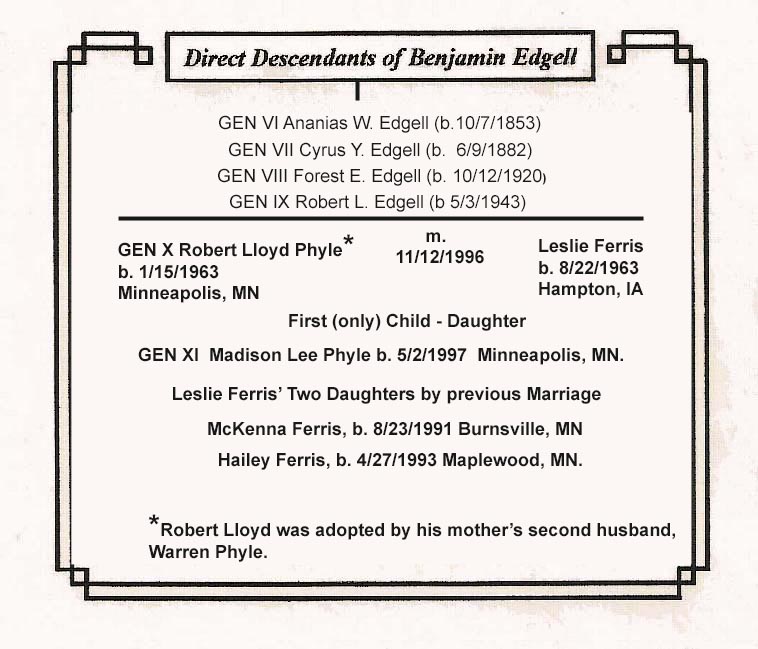
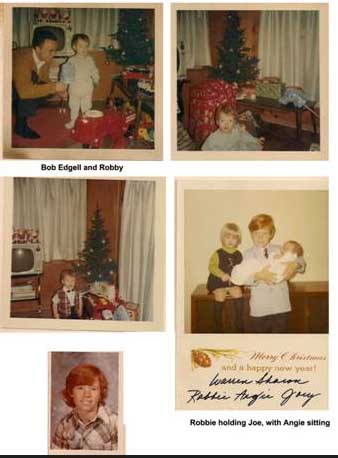

Rob marries Leslie Uhlenhoop.

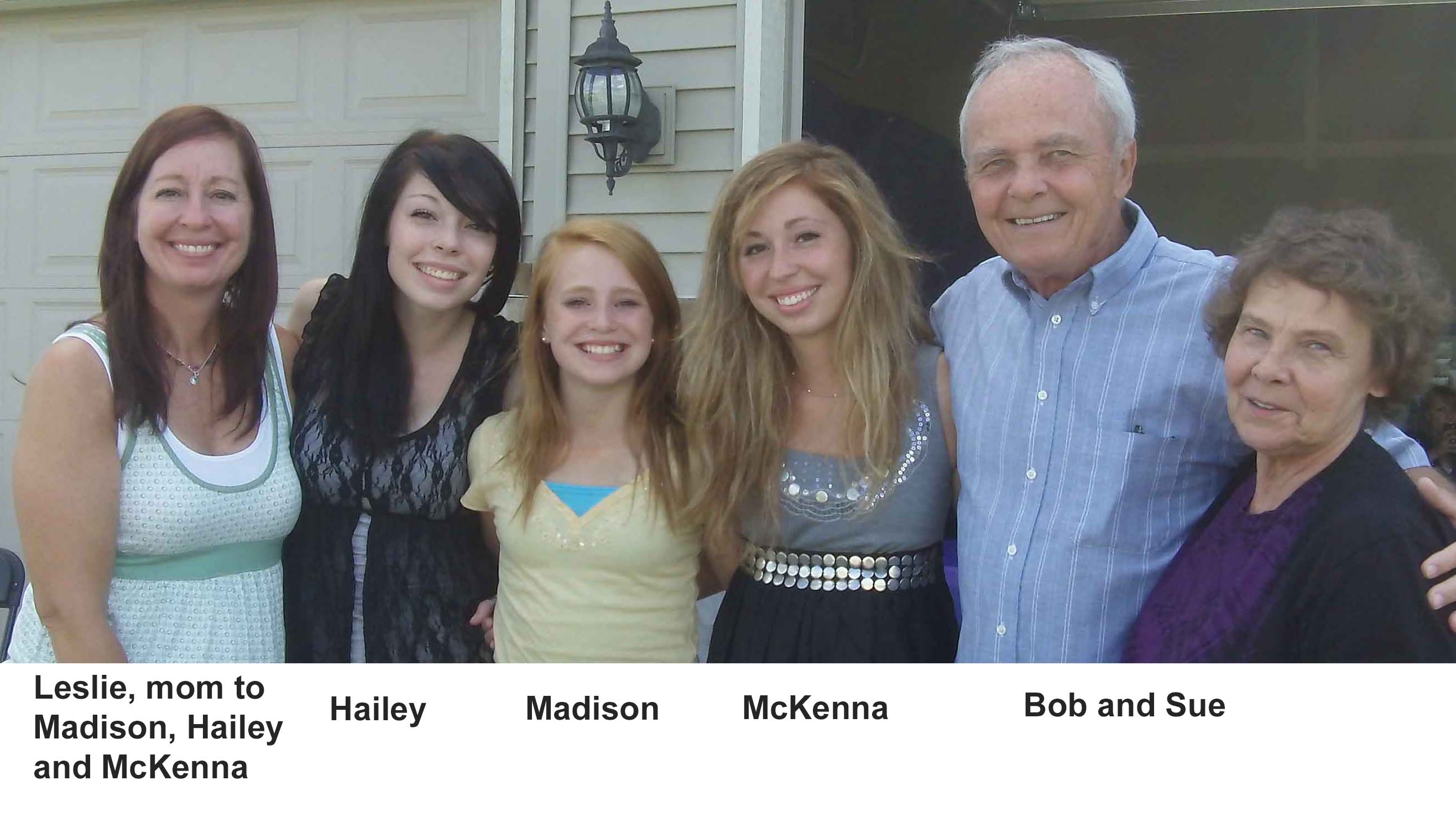
GEN XI Madison Lee Phyle 5/2/1997, Lakeville, Mn. Daughter of Rob and Leslie
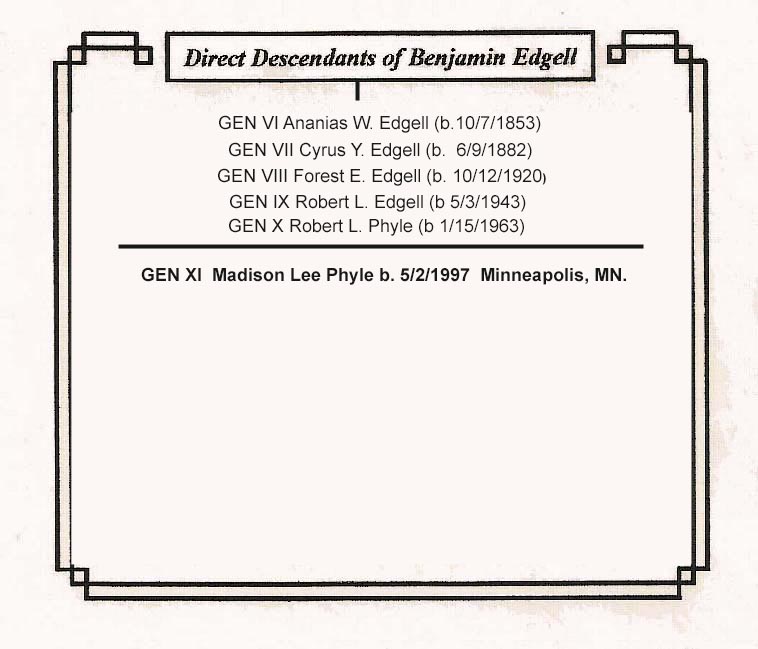
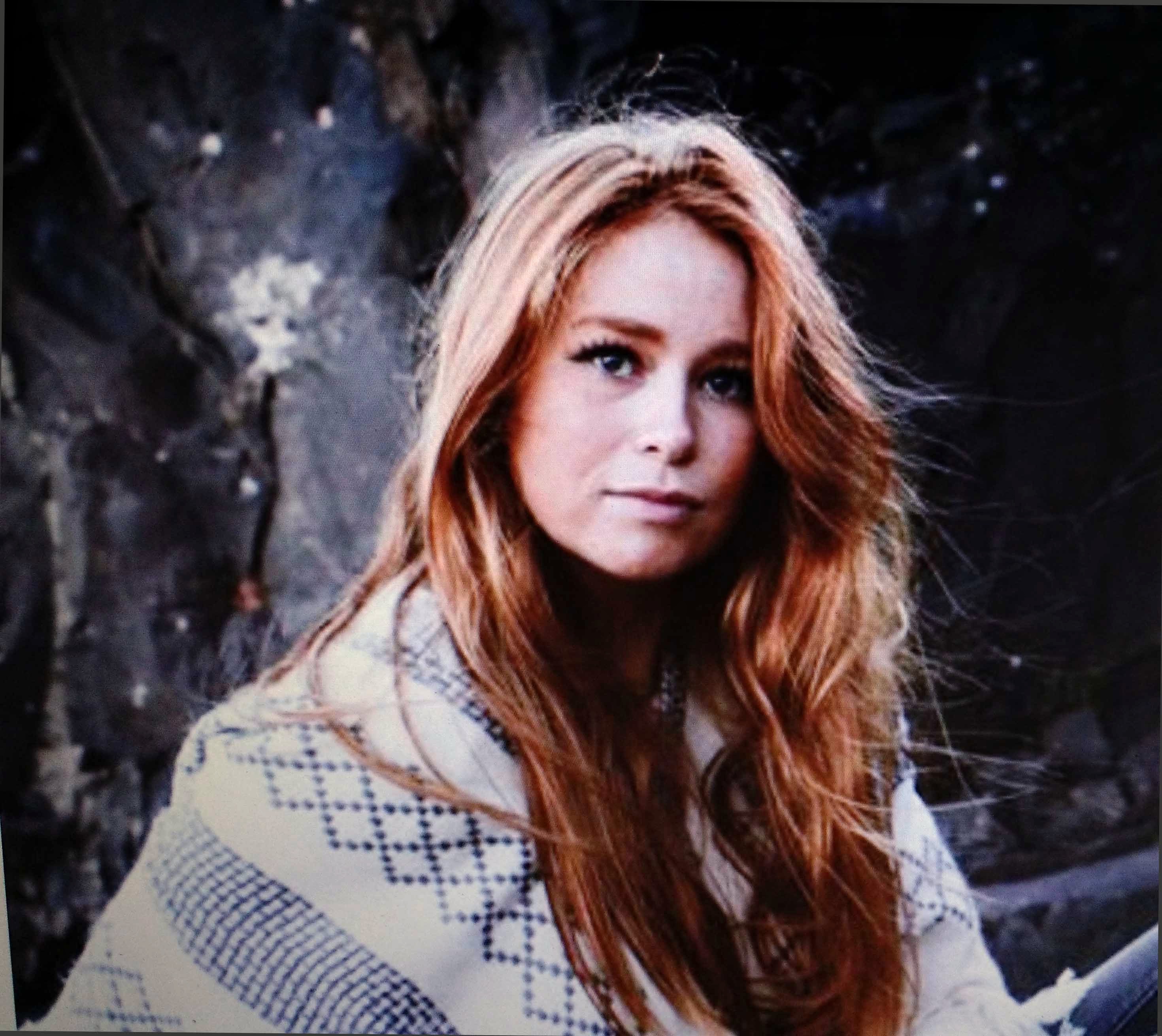
.jpg)
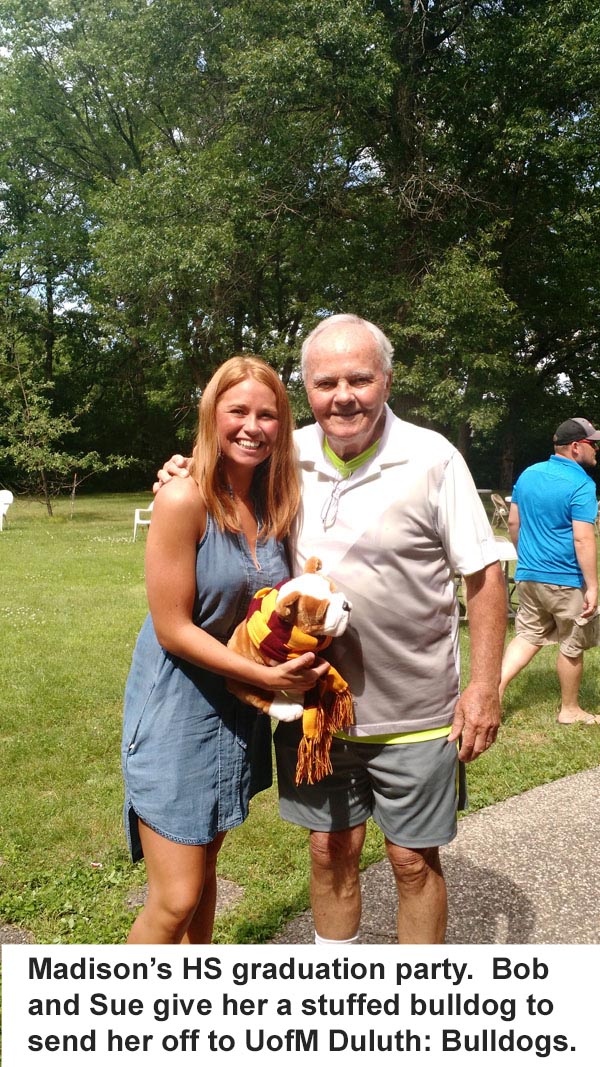

Rob researched and designed this chart of the genealogy of his mother Sharon and his father Bob.
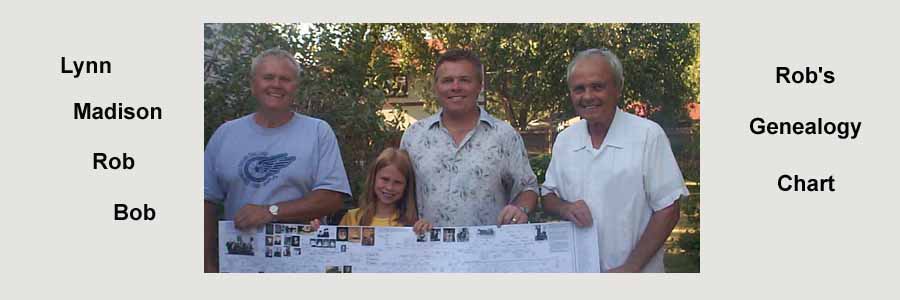
After graduating from High School, Madison attended the University of Minnesota at Duluth. She attended for four years and graduated.
GEN X Robert Lloyd and Leslie divorced and Rob married Corinna Lowe in 2005, Corinna had one son, Carter from a previous marriage.

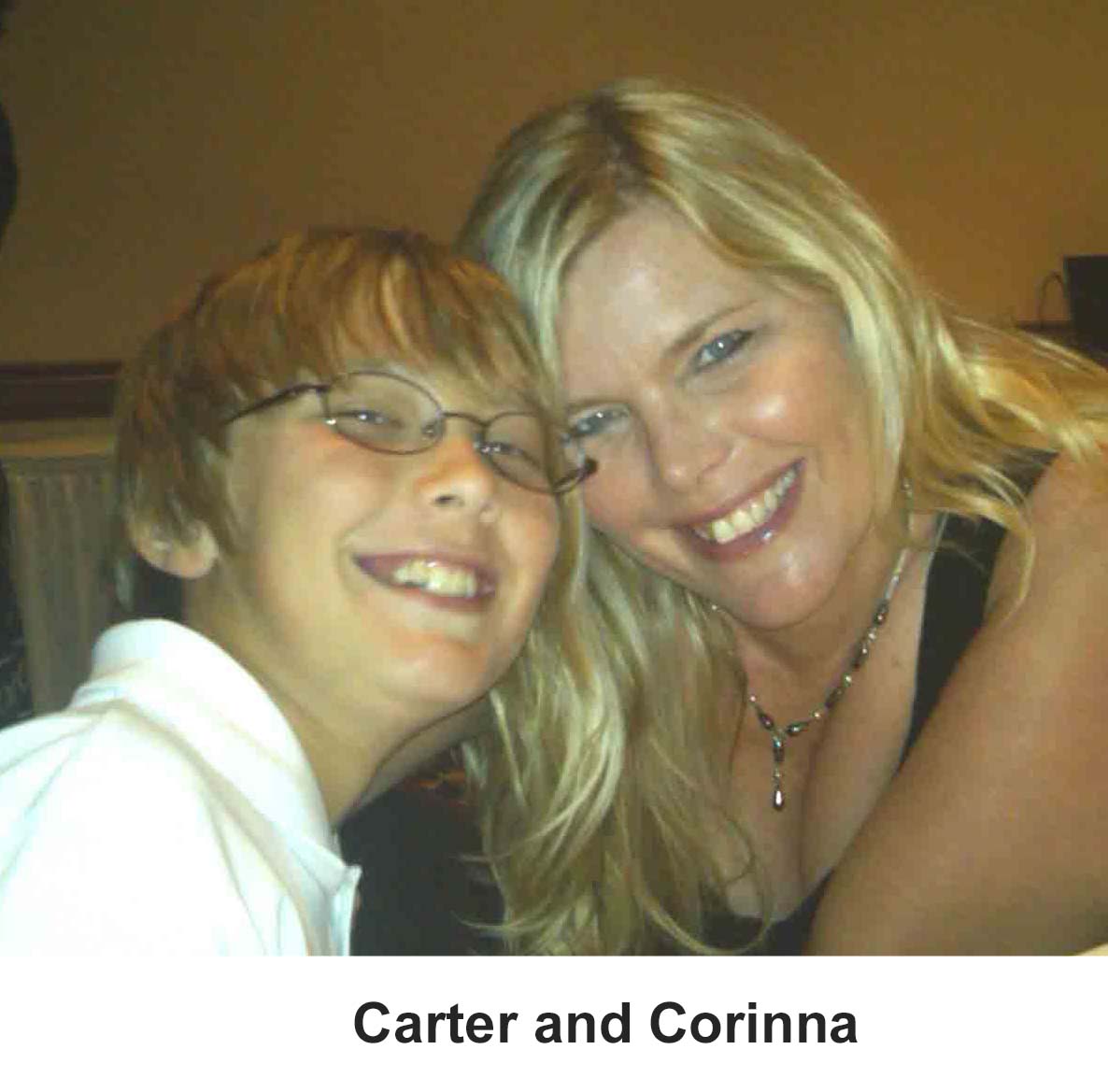


GEN IX Robert Lee Edgell and Sharon divorced in 1965. Bob remarried 1/12/1985 to Susan Marie Riordan (nee Walsh) b. 6/2/1943, Chicago, Illinois (one son by her first marriage: Shawn Riordan (b. 6/3/1969).
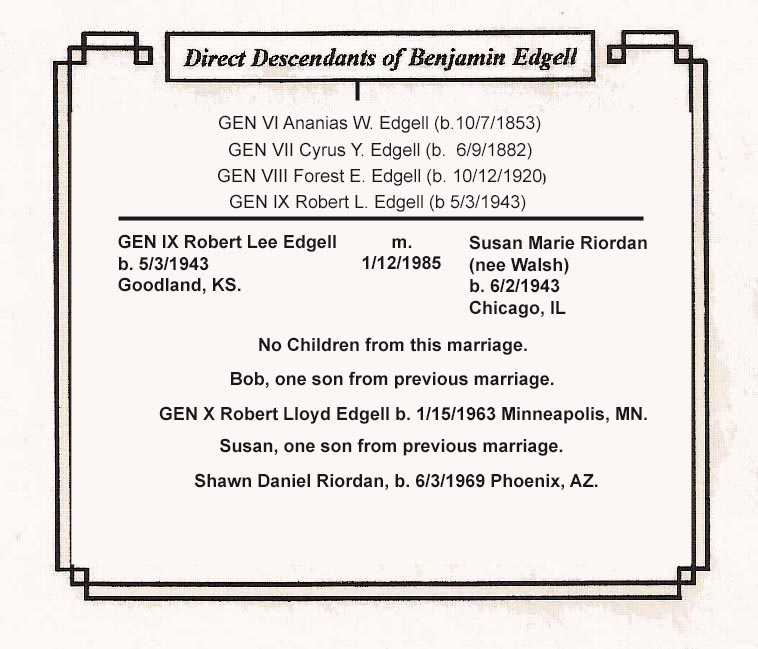


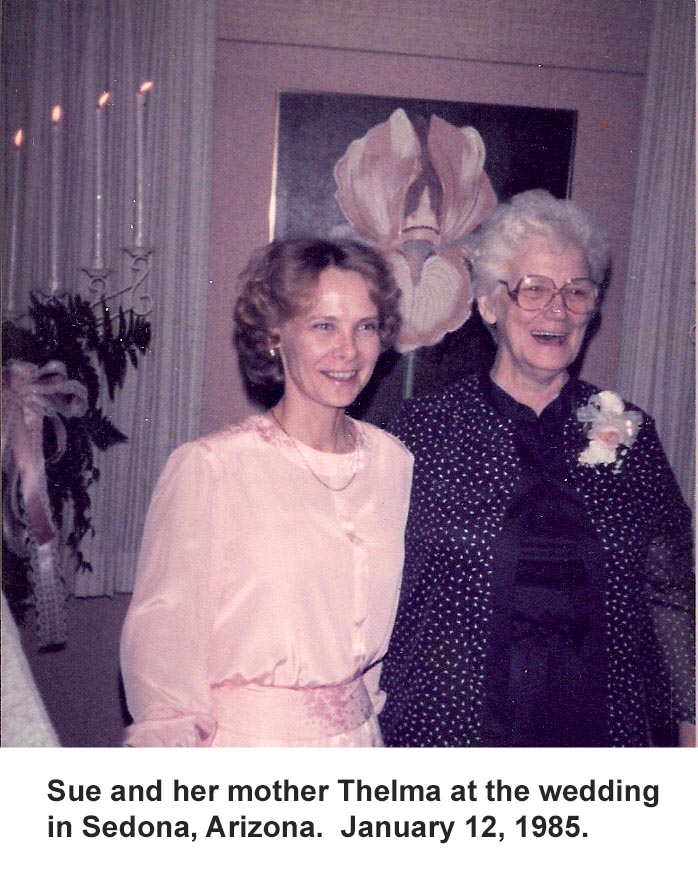

There were many milestones in the life of Bob, Sue and Shawn and they are related in my chronicles above along with photographs..
This genealogy section on the Edgell Genealogy is a work in process. As new information arrives it will be added. Please let me know if you have a contribution: bob@bedgell.com or robertedgell43@gmail.com
************************




